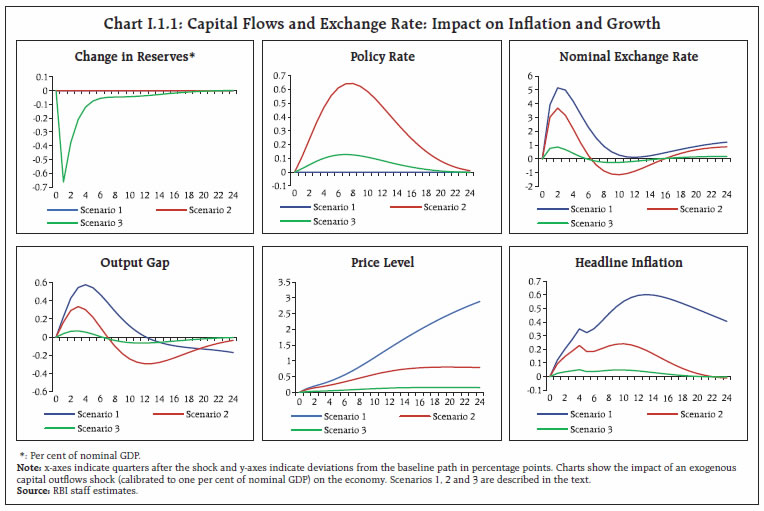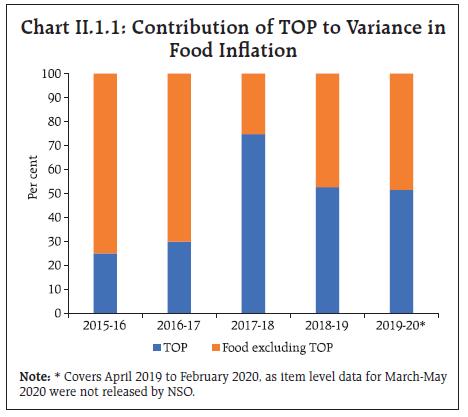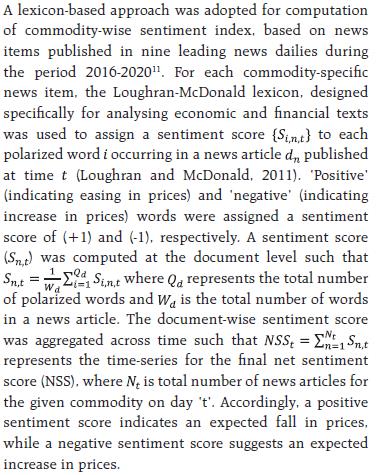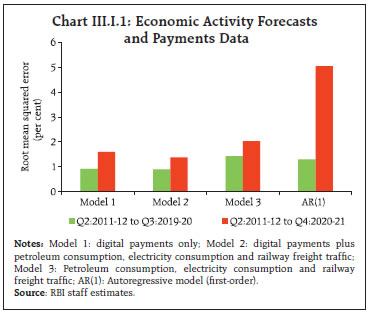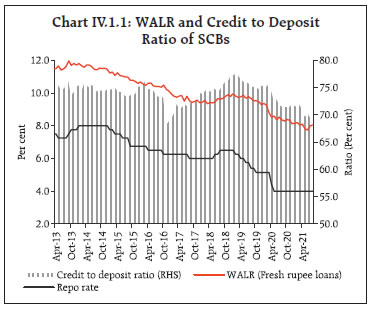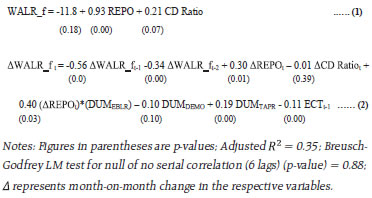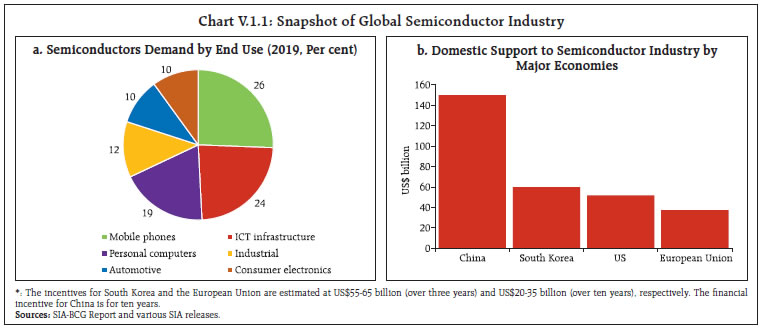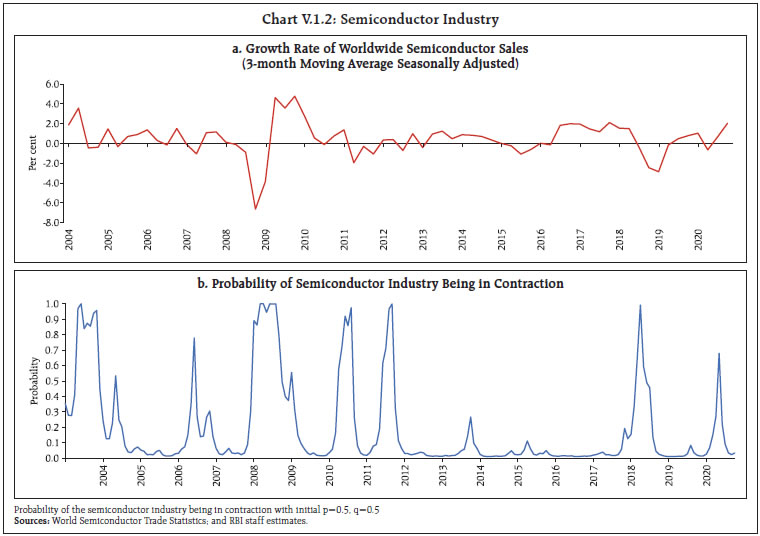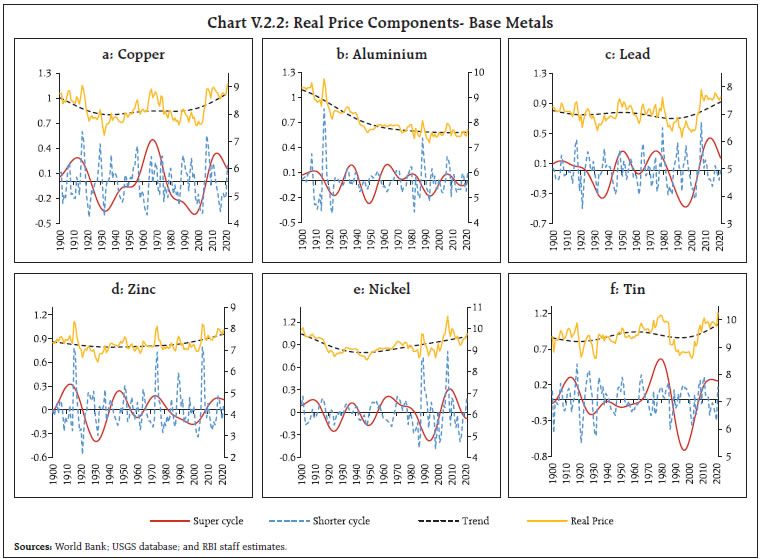 IST,
IST,
Monetary Policy Report - October 2021
Domestic economic activity is normalising after the ferocious second wave retarded momentum. The outlook remains overcast by the future path of the pandemic; the accelerated pace of vaccination and release of pent-up demand provide an upside to the baseline growth path. Headline inflation has fallen back into the tolerance band and the trajectory is expected to be driven by supply-side factors. A faster resolution of supply chain disruptions, good foodgrains production and effective supply management could cause inflation to undershoot the baseline, contingent on the evolution of the pandemic and the efficacy of vaccines. In the months following the retention of the inflation target at 4 per cent with a +/- 2 per cent tolerance band around it for the period 2021-26 by the Government of India (GoI) on March 31, 2021, the monetary policy framework faced a testing challenge from a shock price spike in May 2021. In addition to pandemic-induced disruptions that shaped the trajectory of inflation during the first wave, spillovers from the hardening of commodity prices, especially of crude and edible oil, propelled headline inflation above the upper tolerance band. The episode was short-lived though and inflation has fallen back into the tolerance band. The monetary policy committee (MPC) decided to look through this shock, reading it as supply-driven and transitory. In its meetings in June and August, the MPC maintained status quo on the policy rate and committed to remain accommodative as long as it takes to revive and sustain growth and mitigate the impact of the pandemic on the economy. Developments in the real economy in the first half of 2021-22 have vindicated this stance – shorn of statistical base effects, aggregate demand trails below pre-pandemic levels and considerable slack still prevails in the economy, especially in contact-dependent sectors that faced the brunt of the pandemic. In the second quarter of 2021-22, however, a hesitant recovery is underway, nurtured by the appreciable decline in infections, the stepping up of the scale and speed of vaccinations, and the congenial financial conditions engendered by monetary policy. I.1 Key Developments since the April 2021 MPR Since the release of the April 2021 Monetary Policy Report (MPR), the global macroeconomic environment has been unsettled by diverging paths of economies across the world, between advanced and emerging economies and also among them, mainly differentiated by vaccine access. This is reflected most vividly in monetary policy actions and stances, with some of them staying the course of remaining accommodative and supporting growth and others pre-emptively tightening monetary policy on the assessment that inflation presents a bigger risk. Decoupling of growth paths and the disconnect in monetary policy responses pose downside risks to the global recovery, which already appears to be losing steam. Global economic conditions are also besieged by the resurgence of inflation across the world. Some central banks, mostly in advanced economies (AEs), have judged the rise in inflation as transitory, while some others, mostly in emerging market economies (EMEs) regard breaches of upper tolerance bands as unacceptable and growth threatening. Financial markets are trying to second-guess the commencement of normalisation. Episodic shifts in risk appetite have rendered equity markets frothy with stretched valuations, with intermittent flights into and out of the safety of bonds. Meanwhile, EMEs are awash with capital flows and rotations thereof on taper talk and carry trade and currencies have turned volatile as a result. Several countries that had unlocked their economies and encouraged mobility have faced renewed surges of infections from the Delta variant of the virus, which has turned the evolving global outlook highly uncertain and fragile. Global growth has been supported by strong external demand on the back of buoyant merchandise trade. The World Trade Organization’s (WTO) goods trade barometer hit a high in June 2021 reading. The 20-point year-on-year (y-o-y) rise in the index reflects both the strength of the recent trade expansion and the depth of the pandemic-induced shock in 2020. Worryingly, though, the rate of increase in the index has started to come off, presaging a peaking of the upward momentum in world trade. Container shortages, increased port turnover time and three major shipping alliances controlling much of the supplies have resulted in a jump in freight rates putting the sustainability of the global trade expansion at risk. Services trade continues to lag merchandise trade, with significant contraction in international travel services, although in Q2 some improvement is evident, including through revenge tourism, and increase in transport and other goods related services boosted by demand for goods and freight rates. In India, the recovery that was taking hold from the second half of 2020-21 was disrupted by the second wave of COVID-19 in the weeks following the release of the April 2021 MPR. Although the ferocity of the second wave was not anticipated, the loss of output was about 40 per cent less than during the first wave, as adaptation to pandemic protocols limited restrictions to localised and region-specific containment measures instead of the nation-wide lockdown that was enforced during the first wave. Nevertheless, inflationary pressures became accentuated, as set out earlier, with erosion in fiscal positions. Against this backdrop, the pace of domestic economic activity in Q1:2021-22 (April-June) turned out to be somewhat weaker than anticipated in the April MPR and remained below 2019-20 levels. High frequency indicators of activity suggest that the economy may be pulling out of the second wave’s impact, but uncertainty about the incidence of the third wave makes the outlook fraught with risks.Thus, the pandemic continues to have an overwhelming influence on global and domestic macroeconomic conditions. Virus mutations threaten the progress made through vaccinations and medical responses. Infections keep flaring up in various geographies, forcing authorities to re-impose restrictions/lockdowns restraining economic activity. At the same time, greater adaptability, rising vaccination coverage and continuation of policy support are working towards mitigating the effects of new waves of the pandemic. Equal and universal vaccination holds the key to a brighter outlook, both globally and domestically. Monetary Policy Committee: April-September 2021 During April-September 2021, the MPC met thrice. In the April meeting, the MPC noted that supply side pressures on inflation could persist while demand-side pull remains moderate. On the gross domestic product (GDP) growth outlook, the jump in COVID-19 infections in certain parts of the country and the associated localised lockdowns were seen as dampening the demand for contact-intensive services, restraining growth impulses and prolonging the return to normalcy. In such an environment, the MPC observed that continued policy support remained necessary and unanimously voted to keep the policy repo rate unchanged and to continue with the accommodative stance as long as necessary to sustain growth on a durable basis and mitigate the impact of COVID-19 on the economy, while ensuring that inflation remained within the target going forward. In the June 2021 meeting, the MPC observed that the rising trajectory of international commodity prices, especially of crude, together with logistics costs, posed upside risks to the inflation outlook with weak demand conditions tempering the pass-through to core inflation. On the growth outlook, the MPC noted that the second wave of COVID-19 had altered the near-term outlook, and policy support from all sides – fiscal, monetary and sectoral – was required to nurture recovery and expedite return to normalcy. Accordingly, the MPC decided unanimously to maintain status quo on the policy repo rate and continue with the accommodative stance. When the MPC met in August, headline inflation had breached the upper threshold for the second month in succession in June due to strong momentum in the May print running across all the major sub-groups. The MPC assessed that the inflationary pressures were largely driven by transitory supply shocks while stressing that it was conscious of its objective of anchoring inflation expectations. On growth, the MPC noted that the outlook for aggregate demand was improving, but it was still weak and there was a large amount of slack in the economy, with output below its pre-pandemic level. It judged that the nascent and hesitant recovery needed to be nurtured. Accordingly, the MPC decided unanimously to keep the policy repo rate unchanged and on a 5 to 1 majority to continue with the accommodative stance. The MPC’s voting pattern on the policy repo rate setting during H1:2021-22 reflected broader unanimity in members’ assessments and expectations, mirroring the voting outcomes in a number of other central banks (Table I.1). Macroeconomic Outlook Chapters II and III analyse the macroeconomic developments during H1:2021-22 (April-September). For the updated projections set out in this Chapter, the evolution of key macroeconomic and financial variables over the past six months warrants revisions in the baseline assumptions as set out below (Table I.2). First, global crude oil prices have hardened substantially since the April MPR on the back of a rebound in demand and regulated production by the Organization of the Petroleum Exporting Countries (OPEC) plus. Crude prices initially eased from July 2021 highs on the back of the decision by OPEC plus to increase production by 0.4 million barrels per day on a monthly basis starting August and the moderation in demand due to renewed surge in COVID-19 infections. Crude prices, however, hardened again in August-September on supply disruptions due to hurricanes and fall in inventories. Taking into account these developments, crude prices (Indian basket) are assumed at US$ 75 per barrel in the baseline, 16 per cent above the April 2021 MPR baseline (Chart I.1). Second, the nominal exchange rate (the Indian rupee or INR vis-à-vis the US dollar) has exhibited two-way movements in a range of INR 72-75 per US dollar since April 2021. After depreciating in early-April on concerns about the economic fallout from the second wave, the INR remained under appreciating pressures until May 2021. It depreciated again in June on a strengthening US dollar and rising crude oil prices. The INR appreciated in August with the resumption of portfolio flows, but this was reversed in September. Taking these developments into consideration, the exchange rate is assumed at INR 74.3 per US dollar in the baseline as against INR 72.6 in the April MPR. 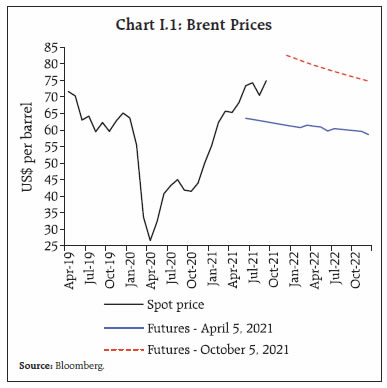 Third, the strength of global growth and external demand has been stronger than the April MPR baseline, albeit with some loss of momentum in recent months over renewed infections and persisting global supply-demand imbalances in key inputs such as chips and semiconductors (Chapter V). Growth prospects of AEs have improved significantly on better vaccine coverage and higher fiscal support relative to emerging market and developing economies (EMDEs) (Chart I.2). After a strong rebound in Q1:2021, the pace of expansion in global merchandise trade has slowed, weighed down by elevated shipping charges and logistics costs. The global manufacturing purchasing managers’ index (PMI) remained in expansion at 54.1 in September 2021, unchanged from August's six-month low as supply chain issues continued to hinder output growth.  Consumer price index (CPI) inflation breached the upper tolerance threshold of 6 per cent in May and June 2021 driven by supply-side pressures in food, fuel and core inflation. In August 2021, inflation eased to 5.3 per cent, aided by a moderation in momentum and favourable base effect. Looking ahead, the three months and one year ahead median inflation expectations of urban households fell by 50 basis points (bps) and 60 bps, respectively, in the September 2021 round of the Reserve Bank’s survey, tracking actual inflation dynamics.1 The proportion of respondents expecting the general price level to increase by more than the current rate decreased for three months ahead horizon but increased for one year ahead horizon vis-à-vis the previous round (Chart I.3). Manufacturing firms polled in the July-September 2021 round of the Reserve Bank’s industrial outlook survey expect the cost of raw materials and selling prices to rise further in Q3:2021-22 (Chart I.4).2 Service sector companies participating in the services and infrastructure outlook survey also expect further rise in input cost pressure and selling prices in Q3:2021-22.3 According to the respondents in the manufacturing and services PMIs, input and output price pressures persisted in September 2021. 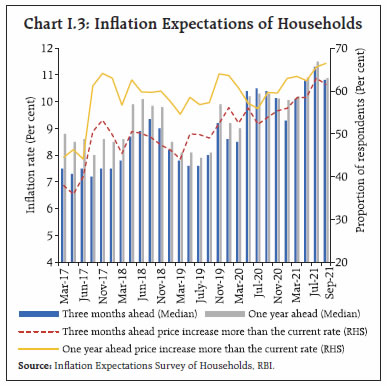 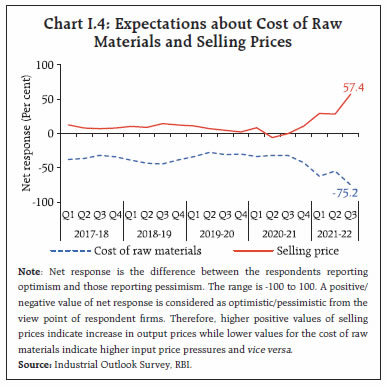 Professional forecasters surveyed by the Reserve Bank in September 2021 expect CPI inflation to ease from 5.3 per cent in August 2021 to 4.7 per cent in Q3:2021-22 and subsequently move up to 5.7 per cent in Q4:2021-22 before easing to 4.9 per cent in Q2:2022-23 (Chart I.5).4 Kharif sowing has progressed satisfactorily and foodgrains production is estimated to touch a new record which, along with ample buffer stocks of foodgrains, should help to contain cereal prices. Global food, oil and other commodity prices, however, remain firm. Taking into account the initial conditions, signals from forward-looking surveys and estimates from structural and other time-series models, CPI inflation is projected to move from 5.6 per cent during Q1:2021-22 to 5.1 per cent in Q2, 4.5 per cent in Q3, and 5.8 per cent in Q4, with risks broadly balanced (Chart I.6). The 50 per cent and the 70 per cent confidence intervals for headline inflation in Q4:2021-22 are 4.4-7.2 per cent and 3.6-8.0 per cent, respectively. For 2022-23, assuming a normalisation of supply chains on the back of improved vaccination, a normal monsoon and no major exogenous or policy shocks, structural model estimates indicate that inflation will move in a range of 4.5-5.2 per cent. The 50 per cent and the 70 per cent confidence intervals for Q4:2022-23 are 2.7-6.3 per cent and 1.7-7.2 per cent, respectively. 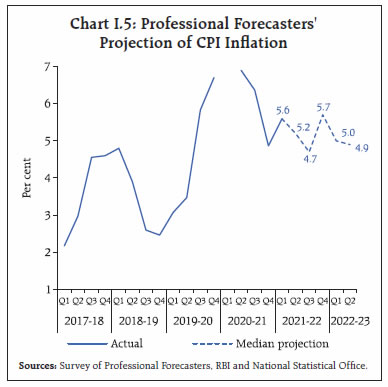 There are a number of upside and downside risks to the baseline inflation forecasts. The upside risks emanate from a longer-than-expected persistence of supply chain disruptions; a further hardening of global commodity prices, especially that of crude oil; a quicker pass-through of input cost pressures to output prices on the back of strong pent-up domestic demand from ebbing infections and vaccination-led consumer confidence; unseasonal rainfall impacting crop production; and global financial market volatility from a faster US monetary policy normalisation. The downside risks arise from an earlier than expected mending of supply chain disruptions; the persistence of weak demand and slack in the economy; and corrections in global commodity and crude prices in the event of a weakening of global demand over new mutants and poor vaccination coverage in low-income countries. 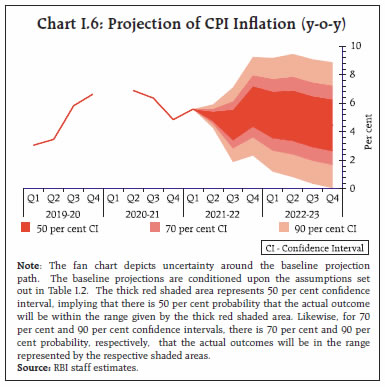 With the ebbing of the second wave, a phased relaxation of the pandemic-related localised restrictions, and improving vaccine coverage, economic activity has been normalising gradually since June 2021. Looking ahead, prospects for the agricultural sector and rural demand look promising, supported by the late revival in kharif sowing. Urban demand is also likely to accelerate with the release of pent-up demand, aided by the significant expansion in the pace of vaccination since July and improving consumer confidence – as of October 6, 2021, nearly 27 per cent of India’s adult population has been fully vaccinated, while 71 per cent has received one dose. This augurs well for the sustenance of contact-intensive activities and consumption demand. The government’s focus on capital expenditure and continued reform push, large foreign direct investment flows, congenial monetary and financial conditions, and boom in the initial public offerings provide a conducive environment for investment activity. There are signs that the investment pipeline could increase in the rest of 2021-22 and in the coming year, given the interest in the production linked incentive (PLI) scheme and the continued focus on road infrastructure. 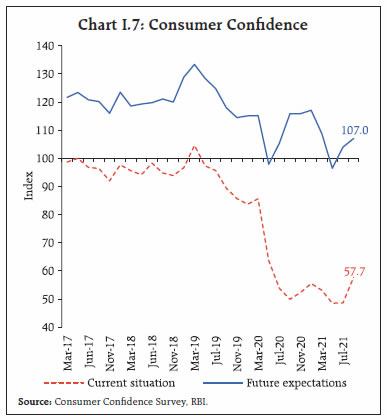 Turning to the key messages from forward-looking surveys, the consumer confidence (the current situation index) in the September 2021 round recovered marginally from the all-time low recorded in May-July 2021, while index for the year ahead remained in the optimistic zone, driven by recovery in sentiments on the general economic situation, the employment scenario and household spending (Chart I.7).5 Sentiments in the manufacturing sector for the quarter ahead strengthened further in the July- September 2021 round of the Reserve Bank’s industrial outlook survey, reflecting optimism on production, order books, capacity utilisation, and employment (Chart I.8). Services and infrastructure sectors expect further strengthening in overall business situation and turnover in Q3:2021-22. Surveys by other agencies released during May-July generally reported a decline in business expectations over the previous rounds but remained upbeat from a year ago (Table I.3). According to the purchasing managers’ survey for September 2021, the one year ahead business expectations of firms in the manufacturing and services sectors were optimistic albeit below historical levels. 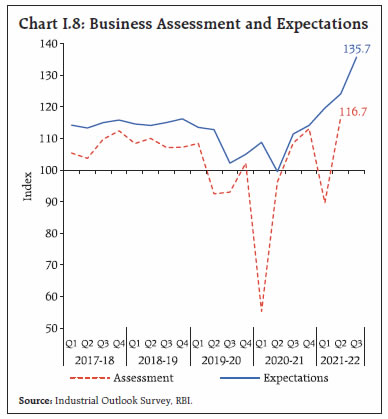 Professional forecasters polled in the September 2021 round of the Reserve Bank’s survey expect real GDP growth to move from 20.1 per cent in Q1:2021- 22 to 5.9 per cent in Q4; it is expected at 13.1 per cent in Q1:2022-23 due to base effects and 6.1 per cent in Q2 (Chart I.9). 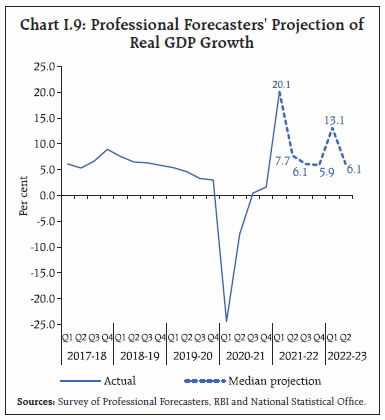 While the near-term prospects are bolstered by the lower base of last year, the outlook is contingent on the evolving COVID-19 trajectory. Taking into account the Q1 growth of 20.1 per cent, baseline assumptions, survey indicators, and model forecasts, real GDP growth is projected at 9.5 per cent in 2021- 22 –7.9 per cent in Q2, 6.8 per cent in Q3, and 6.1 per cent in Q4 – with risks evenly balanced around this baseline path (Chart I.10 and Table I.4). For 2022-23, the structural model estimates indicate real GDP growth at 7.8 per cent, with quarterly growth rates in the range of 5.0-17.2 per cent, assuming restoration of supply chains, a normal monsoon, no major exogenous or policy shocks, and full vaccination. There are upside and downside risks to the baseline growth path. Stronger-than-expected pent-up demand amidst a faster pace of vaccination and mild variants of the virus, and government’s focus on infrastructure investment and asset monetisation and reform measures provide an upside to the baseline growth path. On the contrary, new and more contagious variants of the virus, elevated levels of crude oil and commodity prices, more persistent pandemic-related domestic as well as global supply bottlenecks and global financial market volatility pose downside risks to the baseline growth path. The baseline projections of inflation and growth presented in the previous sections are premised on the assumptions relating to key domestic and international macroeconomic and financial conditions set out in Table I.2. The inherent uncertainties around these assumptions, exacerbated by COVID-19 and its variants, have a significant bearing on the inflation and growth trajectories. Some plausible alternative scenarios to assess the balance of risks around the baseline projections are presented in this section.  (i) Global Growth Uncertainties While the global growth outlook has been upgraded relative to the April MPR, it remains highly susceptible to COVID-19’s trajectory in view of the uneven spread of vaccination across countries and more contagious new variants of the virus, apart from volatility in global commodity prices and the elevated uncertainty over US monetary policy normalisation. First, continuing global supply chain disruptions are adversely impacting production in several manufacturing activities and could dampen global growth more than currently anticipated with additional headwinds from the steep increase in natural gas prices in recent weeks. Second, a slowing Chinese economy may drag down external demand. Third, if the inflationary pressures emanating from the demand-supply bottlenecks in the US and other AEs were to turn out to be persistent, it could trigger an earlier exit than currently being telegraphed from the accommodative policies in the major AEs, induce large financial market volatility and pose downside risks to global growth. Fourth, an escalation of geo-political tensions remains a potential source of downside risk to global growth. In such a scenario, if the global recovery slips by 100 bps below the baseline, domestic growth and inflation could be lower by around 40 bps and 30 bps, respectively. Conversely, a more widespread and equitable distribution of vaccines across the world, sustained success in containing the spread of new mutants, faster resolution of logistic bottlenecks, and the spike in inflation in major AEs reversing quickly could boost global economic activity. In such a scenario, assuming that global growth surprises by 100 bps on the upside, domestic growth and inflation could edge higher by around 40 bps and 30 bps, respectively (Charts I.11a and I.12a). (ii) International Crude Oil Prices International crude oil prices have firmed up amidst elevated volatility with the gradual resumption in economic activity, improvement in global demand and calibrated output normalisation by the OPEC plus. The supply-demand dynamics in the global oil market are subject to several uncertainties. On the supply side, shortfall in the OPEC plus production and rise in geo-political tensions could constrain supply and increase oil prices above the baseline. On the demand side, a better containment of COVID-19 infections could induce higher global growth, a faster closing of the global output gap and a sharper increase in international crude oil prices. Assuming crude oil prices to be 10 per cent above the baseline (Table I.2), domestic inflation could be higher by 30 bps and growth weaker by around 20 bps over the baseline. Conversely, crude oil prices could soften below the baseline if the global recovery is more subdued owing to a faster spread of virus mutations, delays in vaccination or improved supplies of shale gas. In this scenario, if the price of the crude falls by 10 per cent relative to the baseline, inflation could ease by around 30 bps with a boost of 20 bps to growth (Charts I.11a and I.12a). (iii) Exchange Rate The INR has exhibited two-way movements over the past six months, reflecting both global and domestic factors. The divergent paths of recovery across AEs and EMEs and the risk of currently elevated inflation in AEs acquiring a more structural character could necessitate an early exit from ultra-accommodative monetary policies by the AE central banks. The resultant heightened volatility in global financial markets could lead to a generalised risk aversion to EMEs assets, capital outflows and downward pressures on their currencies (Box I.1). A 5 per cent depreciation of INR from the baseline (Table I.2) in such a scenario could increase domestic inflation by up to 20 bps, while GDP growth could be higher by 15 bps through a boost to exports. On the other hand, given India’s relatively better growth outlook, boost to growth from the expanding scale of vaccination and reform measures by the government to attract foreign capital, INR could appreciate. In such a scenario, if the INR appreciates by 5 per cent relative to the baseline, inflation and growth could moderate by around 20 bps and 15 bps, respectively (Charts I.11b and I.12b). 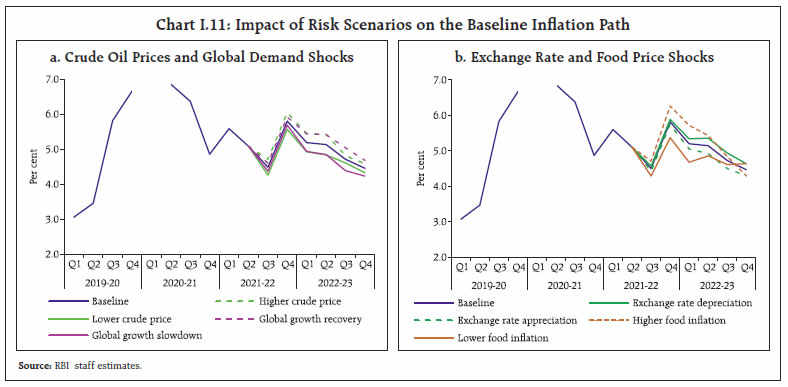
(iv) Food Inflation Food inflation moderated in July-August from the recent peak in June 2021, driven largely by the deepening deflation of vegetable prices. Inflation in edible oil prices, however, remains substantially elevated at 33.0 per cent in August. The expectations of record kharif foodgrains production and large buffer stocks for cereals augur well for food prices. These developments along with continued effective supply management of key food items and easing of international food prices could soften headline inflation by around 50 bps. Conversely, a further hardening of international food prices, demand-supply imbalances in some food items and unseasonal rainfall could exert upward pressure on headline inflation by around 50 bps (Charts I.11b and I.12b). 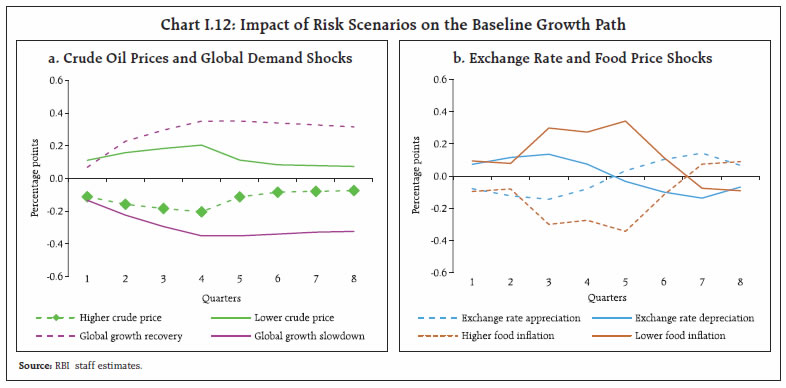 Domestic economic activity is normalising after the ferocious second wave retarded momentum. The outlook remains overcast by the future path of the pandemic; however, the accelerated progress in the pace of vaccination, release of pent-up demand in the upcoming festival season, boost to investment activity from the government’s focus on infrastructure and asset monetisation, and accommodative monetary and liquidity conditions provide an upside to the baseline growth path. While the inflation trajectory is expected to be driven by supply-side factors and risks are to the upside, a faster resolution of global as well as domestic supply chain disruptions, softer international crude oil and food prices as pent-up demand normalises, and another round of good foodgrains production and effective supply management, could cause inflation to undershoot the baseline, contingent on the evolution of the pandemic and the efficacy of vaccines. __________________________________________________________________________________1 The Reserve Bank’s inflation expectations survey of households is conducted in 18 cities and the results of the September 2021 survey are based on responses from 5,958 households. 2 The results of the July-September 2021 round of the industrial outlook survey are based on responses from 1,414 companies. 3 Based on 788 companies polled in July-September 2021 round of services and infrastructure outlook survey. 4 34 panellists participated in the September 2021 round of the Reserve Bank’s survey of professional forecasters. 5 The survey is conducted by the Reserve Bank in 13 major cities and the September 2021 round is based on responses from 5,237 respondents. 6 The QPM is a semi-structural, forward-looking, open economy, calibrated, gap model in the New Keynesian tradition and provides an internally consistent analysis of various feedback mechanisms (RBI, 2021). Consumer price index (CPI) inflation remained highly volatile during March-August this year – after moderating close to the target rate in April, it rose abruptly to breach the upper tolerance threshold during May-June with a sharp pickup in food, fuel and core inflation and moderated in July-August on substantial softening in food inflation. Costs of farm and non-farm inputs remained elevated. Nominal rural wages for both agricultural and non-agricultural labourers were stagnant while staff costs in the organised sector rose. Since the publication of the April 2021 MPR, headline CPI inflation1 that had fallen close to the target rate of 4.0 per cent in April, sprang back amidst the second wave of intense infections to breach the upper tolerance threshold and touched 6.3 per cent during May-June 2021.2 This unanticipated spike came from a sharp pick-up in food and core (CPI excluding food and fuel3) inflation which peaked peaked at 6.6 per cent in May 2021 – the highest since May 2014, and fuel inflation which at 12.6 per cent in June 2021 was the then highest recorded in the CPI series. In the following months, however, inflation quickly moderated by one percentage point to 5.3 per cent by August on a substantial softening in food inflation even as fuel infation scaled another high and core inflation remained sticky and elevated. On the whole, CPI inflation has been highly volatile in the five months of the current financial year – moving within a wide range of 4.2 per cent to 6.3 per cent – averaging 5.5 per cent (Chart II.1). The Reserve Bank of India (RBI) Act enjoins the RBI to set out deviations of actual inflation outcomes from projections, if any, and explain the underlying reasons thereof. The April 2021 MPR had projected range-bound movement in CPI inflation – an average of 5.0 per cent in Q4:2020-21 to 5.2 per cent in Q1 and Q2 of 2021-22. Actual inflation for Q1:2021-22 at 5.6 per cent and Q2:2021-22 (July-August) at 5.4 per cent turned out to be higher than the projections by 35 bps and 27 bps, respectively (Chart II.2). 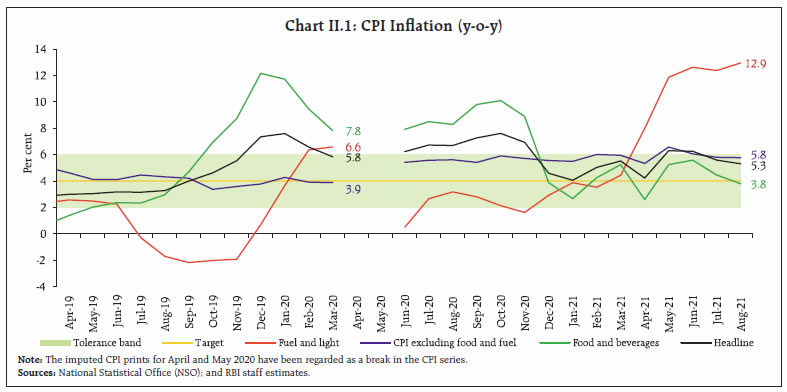 A number of factors impinging on food, fuel and core contributed to this overshoot. First, the rapid spread of COVID-19’s second wave at the start of 2021-22 resulted in restrictions on activity being imposed over a large swath of the country. These restrictions, in turn, resulted in transitory price pressures in Q1, especially in May, through supply-chain disruptions, elevated retail margins as well as from difficulties in accurate price measurements due to localised lockdowns and restrictions on non-essential commercial activities in several states.4 As restrictions eased and activity normalised, the effects of these factors dissipated from June. Second, the unanticipated surge in global energy prices kept petrol and diesel inflation firmly in double digits. The April 2021 MPR had assumed an Indian basket crude oil price of US$ 64.6 per barrel during 2021-22; however, crude oil prices edged up to a peak level of US$ 75 per barrel in early July before moderating to US$ 70 per barrel by end-August. Third, there was an extraordinary surge in international edible oil prices which fed into domestic inflation formation.5 Fourth, the persistence of industrial input and transport cost pressures and subsequent transmission to selling prices of manufactured goods was more than what was anticipated, in spite of demand conditions weakening due to the second wave. 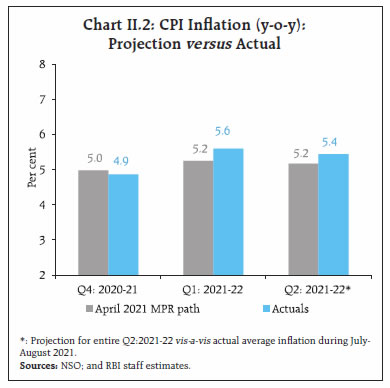 A dip in inflation to 4.2 per cent in April 2021 was overwhelmed in May 2021 by a sharp pick up in price momentum6 spanning across food, fuel and core groups, resulting in a surge in inflation by 2.1 percentage points to 6.3 per cent. In June, headline inflation plateaued, with positive price momentum completely neutralised by a favourable base effect which became even larger in July and more than offset the broad-based price momentum taking down headline inflation to 5.6 per cent in July. With overall price momentum registering a sharp deceleration in August, coming from a steady food price index, headline inflation moderated further to 5.3 per cent (Chart II.3). The distribution of CPI inflation during January- August 2021 varied distinctly from the pattern in the past few years. There has been a shift in the mean of the distribution from 3.4 per cent for 2017- 2019 (January-August) to 5.3 per cent in 2021 so far (Chart II.4). This was accompanied by an increase in volatility – with the standard deviation in 2021 more than two times that of 2017-2019 – and positive skewness, compared to a negative skew for the 2017-2019 period. These indicate high dispersion of inflation rates in the CPI basket, along with a larger number of items experiencing higher inflation rates than in the pre-pandemic period. The positive skew reflected outlier double-digit inflation in the CPI distribution, primarily on account of oils and fats. 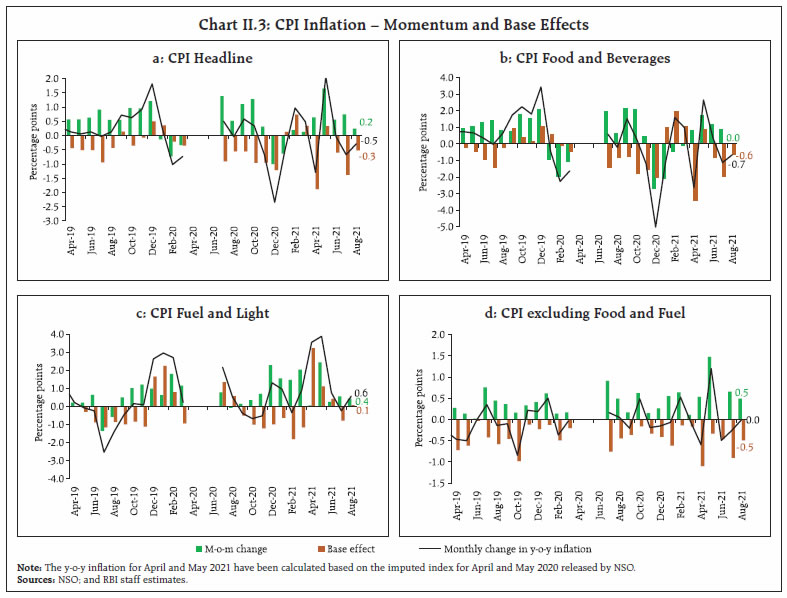 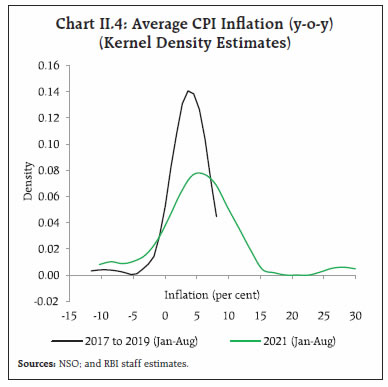 During April-August 2021, 8 of the 23 sub-groups in CPI with a cumulative weight of 49.7 per cent contributed 82.7 per cent of CPI inflation, much higher than their contribution of 56.2 per cent in 2020-21 (Table II.1). The non-seasonally adjusted diffusion indices of price changes7 remained elevated (barring for services in June), indicative of price increases being broad-based across the CPI basket (Chart II.5).8 The role of various factors impinging upon inflation dynamics can be captured through vector autoregression (VAR) estimates and historical decomposition.9 Inflationary pressures in Q1:2021-22 can be attributed to adverse supply shocks, firming up of asset prices and easy monetary conditions, even as muted demand conditions contributed to a softening of inflationary pressures. By Q2:2021-22 some softening in inflationary pressures came about from softening of wage pressures (Chart II.6a).  In terms of contribution of goods and services to headline inflation, the pick-up in inflation in June 2021 emanated from perishables – edible oils, fruits and vegetables – and semi-perishable goods (non-durable goods with a 30-day recall10) like LPG, kerosene, petrol, diesel, medicines and fast-moving consumer goods (FMCGs). In July-August, the contribution of perishables to headline inflation registered a sharp moderation, even as the contributions of semi-perishables, durables and services to headline inflation were largely steady (Chart II.6b). Some of the stickiness in semi-perishables and durables goods inflation reflected the transmission of high international prices. The surge in international prices of edible oil, silver and petroleum products resulted in an increase in the contribution of imported components to headline inflation – from 0.8 percentage points in February to a peak level of 1.9 percentage points in June before moderating to 1.4 percentage points in August 2021 (Chart II.6c). 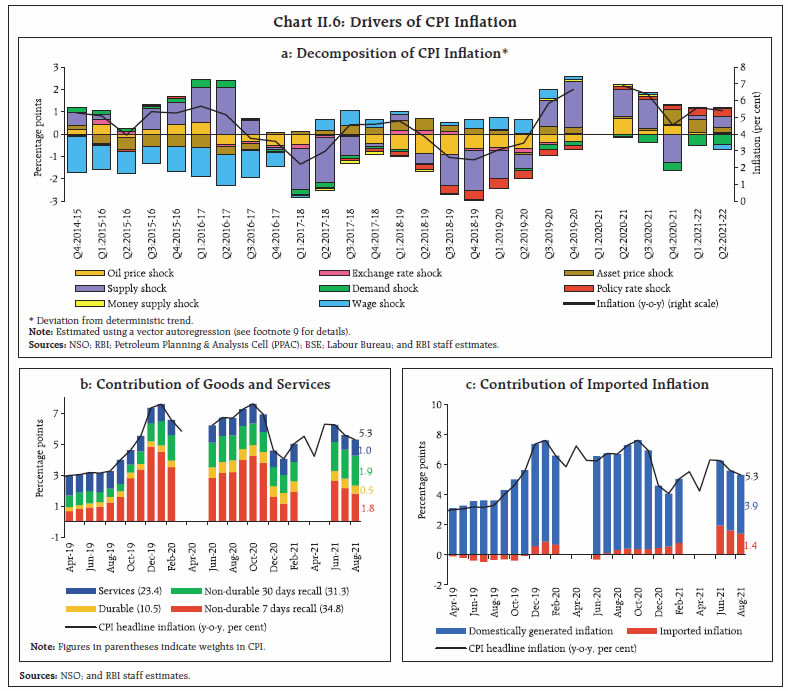 Food Group Food and beverages inflation treaded within a range of 2-6 per cent during March-August 2021 and on an average contributed around 37.2 per cent of headline inflation (CPI food has a weight of 45.9 per cent in the CPI basket). Elevated international prices of edible oils along with price pressures in protein rich items remained the major drivers (Chart II.7). The summer uptick in vegetables prices during May-July 2021 led to an increase in price pressures, while a decline in prices of cereals, protein-based food and fruits along with a sharp deceleration in vegetable price momentum in August 2021 provided relief dragging down food inflation to 3.8 per cent. Overall, the food price build-up in the financial year so far has been lower than historical patterns, even as price build-ups in oils and fats, eggs, meat and fish, non-alcoholic beverages and spices were higher than their long-term averages (Chart II.8). Excluding vegetables, during April-August 2021, food and headline inflation would have averaged 6.3 per cent and 6.5 per cent respectively, as against an overall average rate of 4.3 per cent for food and 5.5 per cent for headline. Prices of cereals (weight of 9.7 per cent in the CPI and 21.1 per cent in the food and beverages group) remained in deflation during March-August 2021, primarily reflecting favourable base effects and muted momentum. Within cereals, both rice and wheat witnessed subdued price pressures (barring May 2021) on the back of ample buffer stocks relative to norms (2.7 times and 1.8 times for rice and wheat, respectively, as on September 16, 2021) and distribution under Pradhan Mantri Garib Kalyan Anna Yojana (PMGKAY). In May 2021, restrictions on activity across many states affected supply chains leading to a pick up in prices. Moreover, production remained robust, with an increase of 2.9 per cent for rice and 1.5 per cent for wheat (as per the 4th Advance Estimates (AE) 2020-21) over 2019-20 Final Estimates (FE).  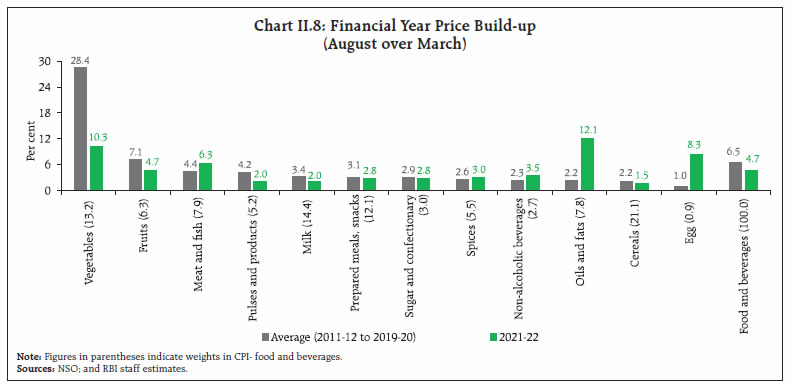 In the case of vegetables (weight of 6.0 per cent in the CPI and 13.2 per cent in the food and beverages group), prices remained in deflation during March-August 2021 (Chart II.9), reflecting, inter alia, favourable base effects. The three key vegetables – tomatoes, onions and potatoes – largely witnessed price increases during May-July 2021 less than the usual summer uptick. While prices of potatoes and onions eased in August 2021, tomato prices picked up due to lower supply in the markets as the lean period set in. Crop damage due to heavy rains and flood like situations in major tomato producing states such as Andhra Pradesh and Karnataka also impacted mandi arrivals. After moderating during March-May 2021, onion prices edged up subsequently, reflecting the seasonal uptick as well as damage to stored rabi onions in Maharashtra and Gujarat due to cyclone Tauktae. Potato prices were in deflation during June-August 2021, reflecting favourable base effects and easing of prices in August 2021 with higher production (10.6 per cent in 2020- 21) in response to elevated prices observed in the previous year, and higher cold storage stocks in major producing states. On the whole, as noted earlier, the price build-up in vegetables remained lower than their historical average in the financial year so far, reflecting the recovery of production (higher by 4.2 per cent in 2020-21 2nd AE compared to 2019-20 FE). 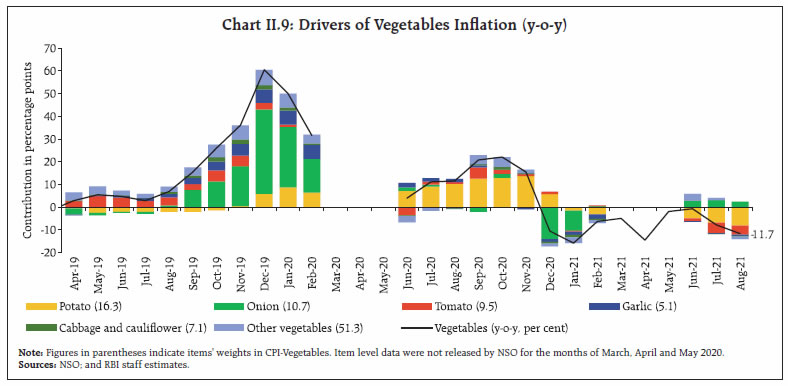 In a rapidly changing scenario where volatility in prices of key vegetables has substantial fallout on headline inflation, there is a need for real time monitoring of price situation, especially in case of perishables. Price sentiment derived from unstructured data contained in news articles can provide useful leading information on prices (Box II.1).
Despite pulses production of 257.2 lakh tonnes during 2020-21, an increase of 11.7 per cent over 2019-20 – augmenting domestic supply and overall stocks, factors like localised lockdowns in the second wave resulted in supply chain driven demand-supply gaps, accentuated by lower arrival of imports and precarious stock positions in the case of masur (Chart II.10). To address the tight demand supply situation, the government undertook several supply side initiatives such as imposing stock limits in July 2021 on some pulses under the Essential Commodities Act, 1955, easing import restrictions to enhance domestic availability of tur, urad and moong, a memorandum of understanding (MoUs) with Myanmar, Malawi and Mozambique for pulses imports, and reducing basic import duty and Agriculture Infrastructure and Development Cess (AIDC) on masur to 0 per cent12 and 10 per cent, respectively. Inflation in meat, fish and eggs witnessed upside pressures during March-July 2021 primarily reflecting feed cost pressures and transportation costs (Chart II.11a). Prices of key items such as eggs, chicken, mutton and fish surged as a consequence of several factors – increase in soybean meal prices (international soybean meal prices increased by 32.3 per cent in July 2021 compared to July 2020); restricted operations of the poultry industry during the second wave; festive demand in July 2021; damage of fishing boats owing to cyclones Tauktae and Yaas; higher fuel prices and the annual ban on fishing in the west coast during monsoons. However, prices eased in August 2021 reflecting seasonal fall in demand during the month of sravana. In the case of milk and products (weight of 6.6 per cent in the CPI and 14.4 per cent in the food and beverages group), a lean season of production coincided with upward revision in retail prices by ₹2 per litre by major milk co-operatives like Amul and Mother Dairy in July 2021 which was followed by many other state milk co-operatives such as Milkfed in Punjab, Gokul in Maharashtra and Parag in Uttar Pradesh, resulting in price pressures in July 2021. Milk cooperatives have cited various reasons for increase in input costs such as cost of transport, feed prices and operational costs of processing and packaging. However, post July 2021, no increase in retail milk prices by other milk cooperatives has been reported.  Inflation in oils and fats experienced price pressures in the post-lockdown period and shot up to an all-time high of 34.8 per cent in June 2021, mirroring elevated international edible oil prices (Chart II.11b). Prices fell in July 2021 in response to the supply side measures announced by the government, before showing some uptick in August to 33.0 per cent. Global palm oil prices escalated due to labour shortage in Malaysia and adverse weather conditions leading to lower than expected production and high export duties on crude palm oil. A number of measures were taken to alleviate price pressures, including reduction in import duty on crude and refined palm oil from 15.0 per cent to 10.0 per cent (effective rate reduced from 35.75 per cent to 30.25 per cent) and 45.0 per cent to 37.5 per cent (effective rate reduced from 49.5 per cent to 41.25 per cent), respectively; mechanism for speedy clearance of crude palm oil at shipping ports and placing the imports of Refined Bleached Deodorized (RBD) palm oil and RBD palmolein under free category from restricted category effective from June 30, 2021 and applicable till December 31, 2021. Further, effective September 11, 2021, import duty on crude and refined palm oil was reduced from 10 per cent to 2.5 per cent (effective rate reduced from 30.25 per cent to 24.75 per cent) and 37.5 per cent to 32.5 per cent (effective rate reduced from 41.25 per cent to 35.75 per cent), respectively. However, price pressures continued in the domestic market (barring in July 2021) as Malaysia increased its export reference price for July 2021, maintaining its export duty at the highest rate of 8.0 per cent. To control domestic edible oil prices, import duty on crude soybean and sunflower oil were reduced from 15.0 per cent to 7.5 per cent, effective August 20, 2021 and it was further reduced to 2.5 per cent from September 11, 2021. Similarly, import duty on refined soybean and sunflower oils was reduced from 45.0 per cent to 37.5 per cent and further to 32.5 per cent with the same effective dates. To attain self-sufficiency in production of edible oil, the Government announced a National Mission on Edible Oil - Oil Palm (NMEO-OP) with an investment of over ₹11,000 crore and assured farmers access to all facilities, from quality seeds to technology. 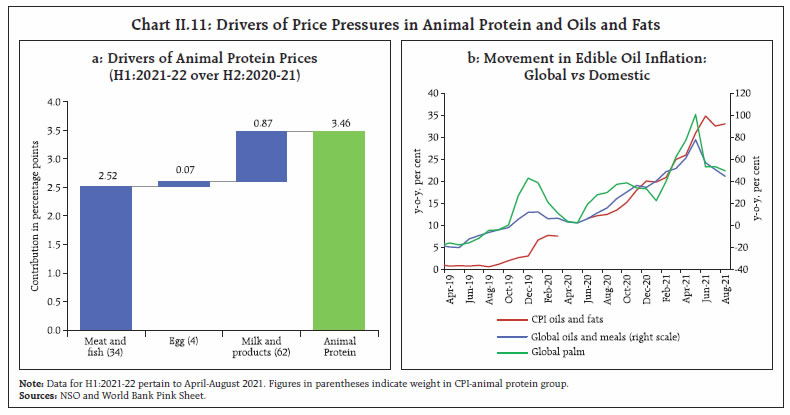 Price of sugar and confectionery (weight of 1.4 per cent in the CPI and 3.0 per cent in the food and beverages group) remained in deflation during March- August 2021, except for June 2021, due to higher domestic availability as a result of robust production (sugarcane production rose by 7.8 per cent in 2020-21 4th AE over 2019-20 FE) and export subsidy for sugar export under MAEQ (Maximum Admissible Export Quota) being reduced to ₹4000 per tonne from ₹6000 per tonne, effective May 20, 2021. Among other items in the CPI food group, prices firmed up in the case of non-alcoholic beverages and prepared meals, reflecting increase in input costs. Retail Margins Retail price margins, defined as the difference between retail and wholesale prices for four major sub-groups – cereals, pulses, vegetables and edible oil – have shown divergent movements.13 The margins in case of edible oils, pulses and cereals have risen unceasingly, since the first wave of the COVID-19 pandemic. Margins in case of vegetables are back to the usual seasonal pattern in absence of any major supply side disturbance (Chart II.12). CPI Fuel Group CPI fuel inflation surged from 4.4 per cent in March 2021 to 12.6 per cent in June 2021 before showing a transitory dip in July. In August 2021, fuel inflation touched an all-time high of 12.9 per cent (Chart II.13a). The year-on-year price changes in LPG and kerosene (PDS) during June-August 2021 were one of the highest recorded in the current CPI series. Market prices of crude and various oil-based fuels have firmed up through the waves of the pandemic pulling up kerosene and LPG fuel prices (Chart II.13c). The contribution of fuel items of rural consumption like firewood and chips was also substantial during June- August 2021 (Chart II.13b and II.13c).  CPI excluding Food and Fuel CPI core inflation, i.e. CPI inflation excluding food and fuel, remained elevated and sticky in the financial year so far, reflecting persistent cost-push pressures even as demand conditions remained sluggish. Core inflation, from a peak level of 6.6 per cent in May, moderated to 6.1 per cent in June and to 5.8 per cent during July-August. Excluding petrol and diesel, it has also remained sticky in the range of 5.1-5.5 per cent throughout the pandemic period (Table II.2). 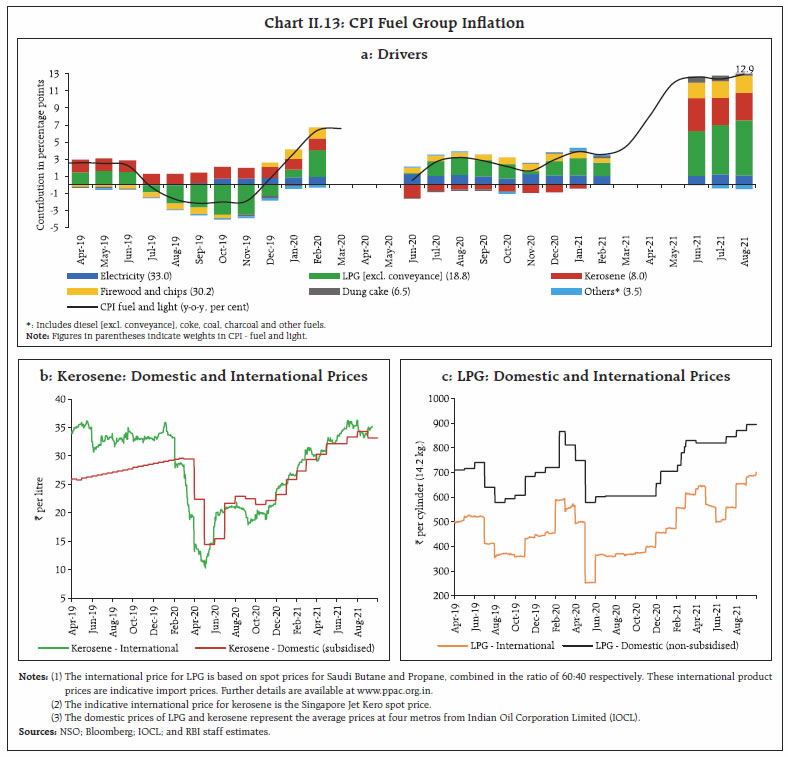 In term of sub-groups, transport and communication, clothing and footwear and health accounted for more than 60 per cent of core inflation (weight of these sub-groups is around 45 per cent in the core CPI). On the other hand, the contributions of housing and education sub-groups to core inflation in the financial year so far have been lower than in the pre-pandemic period (Chart II.14). Overall, goods inflation is driving the core, with petrol and diesel (under the transportation and communication sub-group) registering double digit inflation consecutively since July 2020. Even as the one-off effects of indirect taxes instituted in the post-lockdown period waned from June 2021, the sustained increase in international crude oil prices – by around 104 per cent between end-May 2020 and end-August 2021 – has kept petrol and diesel inflation firm at 23.8 per cent in August. This was starkly evident in the WPI which excluded indirect tax effects; WPI petrol and diesel inflation was at 54.2 per cent in August (Chart II.15a). Petrol pump prices were at historic highs in early 2021 and breached ₹100 per litre by July 2021, with attendant implications for overall cost conditions in the economy (Chart II.15b).  After abstracting the effects of generally volatile items, i.e., food, fuel, petrol, diesel, gold and silver, core inflation rose from 5.1 per cent in February to 5.5 per cent in August, attesting to persistence (Table II.2). A decomposition of CPI excluding food, fuel, petrol, diesel, gold and silver into goods and services components points to contrasting movements. Inflation in the goods component (with a weight of 20.7 per cent in CPI) has been undergoing consecutive increases from August 2020, reaching 6.5 per cent in August 2021. This was driven primarily by clothing and footwear, health care – particularly medicines – household goods like utensils, washing soap/ powder, furniture, personal care items and toiletries (Chart II.16a). On the other hand, services inflation (with a weight of 23.0 per cent in CPI) which was at 4.3 per cent in February, firmed up moderately to 4.5 per cent in August 2021. The contribution of services, on an average, to core inflation was somewhat lower than what was seen in the pre-pandemic period (Chart II.14). A recovery in housing rentals along with rising education services inflation from the post-lockdown historic lows are the key drivers for the uptick in core services inflation between February and August 2021, apart from medical as well as household services (Chart II.16b).   In order to filter noise from CPI inflation and get to the underlying inflation dynamics two common approaches are (i) excluding a fixed set of components from the CPI basket that display volatile price movements and are likely to be transitory; and (ii) excluding different components each month if they are located in the tails of the inflation distribution. The exclusion-based measures show heightened inflationary pressures over the last six months with no decisive signs of softening (Table II.2). Inflation measured by trimmed means, on the other hand, shows some edging down of the underlying inflation pressures in August from the June-July peak (Table II.3). Other Measures of Inflation Over the last 14 months, inflation in sectoral CPIs for agricultural labourers (CPI-AL) and rural labourers (CPI-RL) has remained below CPI headline inflation. Lower food inflation, paired with their higher weights in CPI-AL and CPI-RL contributed to the lower CPI-AL and CPI-RL inflation prints. Inflation in terms of the CPI for industrial workers (CPI-IW) fell below the headline during May-August 2021. WPI inflation registered sharp increases sequentially between February and May 2021 to touch an all-time high of 13.1 per cent (as per the WPI series, 2011-12=100) in May from a sharp and broad-based upsurge in price momentum in an environment of adverse base effects. WPI inflation moderated in June and July 2021, despite positive price pressures, owing to base effects turning favourable, although it remained in double digits. In August, WPI inflation reversed course and edged up to 11.4 per cent primarily on account of an increase in non-food manufactured products inflation, despite softening of food inflation. In line with WPI inflation, the deflators for gross value added (GVA) and gross domestic product (GDP) edged up sharply between Q3:2020-21 to Q1:2021-22. WPI inflation has averaged 11.7 per cent during April- August 2021, remaining markedly above CPI inflation (average of 5.5 per cent) (Chart II.17a). Inflation in petroleum products – especially petrol and diesel – eggs and edible oils diverged considerably between the CPI and the WPI (Chart II.17b). These developments have again brought to fore the possibility of transmission of WPI inflation to the CPI and their long-run relationship (Box II.2). 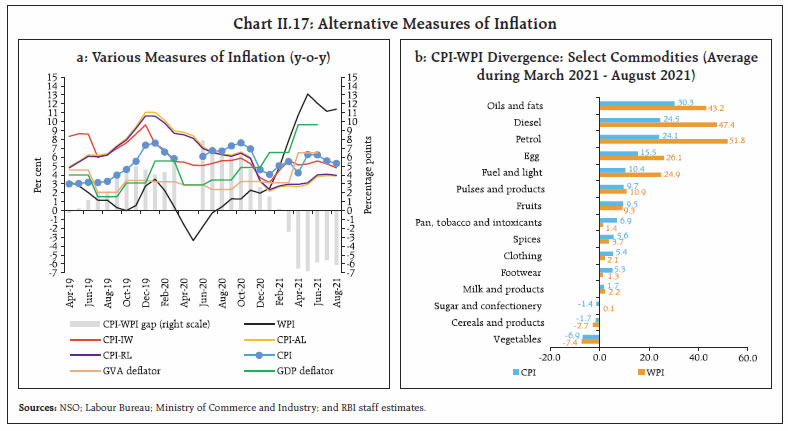
During H1:2021, costs, as measured by inflation in WPI industrial raw materials and farm inputs, increased (Chart II.18). The firming up of global crude oil prices during 2021 impacted the prices of inputs such as high-speed diesel (HSD), naphtha, aviation turbine fuel (ATF), and furnace oil. Prices of non-food articles also increased during March- August 2021. Prices of fibres and oilseeds edged up as international cotton and soybean prices increased. However, inflation in industrial raw materials eased marginally in July 2021 reflecting easing in prices of minerals, bitumen, paper and pulp, before picking up again in August 2021. The increase in farm input price inflation was largely driven by double digit inflation in fodder, due to damage to production from excess rains during September-October 2020, and HSD reflecting firming up of global crude oil prices. Fertiliser prices, on a year-on-year basis, edged up moderately during 2021, reflecting increase in international prices. Prices of electricity – a key input in both industrial and farm inputs – remained muted during H1:2021. Price increase of agricultural machinery and implements, on a year-on-year basis, also stayed subdued, although a gradual pass-through of higher manufacturing costs due to rising commodity prices is underway during March-August 2021. 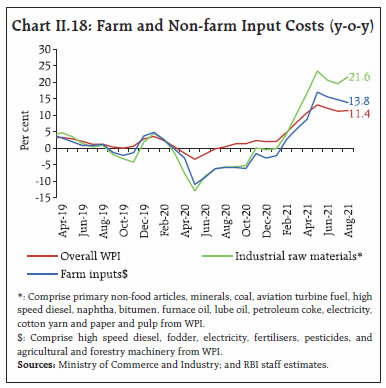 Nominal rural wages for both agricultural and non-agricultural labourers remained stagnant; growth rates of the nominal rural wages eased sharply, on a year-on-year basis, during May-July 2021, attributable to adverse base effects15 (Chart II.19). Growth in the value of production in the organised sector decelerated in contrast to the increase in staff costs for listed firms in the manufacturing sector during Q1:2021-22. In the services sector, staff cost increased sharper than the value of production. As a result, unit labour costs (measured as a ratio of staff cost to value of production) rose from 5.7 per cent in Q4:2020-21 to 6.2 per cent in Q1:2021-22 for firms in the manufacturing sector16 and from 29.1 per cent to 31.5 per cent for firms in the services sector17 (Chart II.20). Input cost pressures and salary outgoes are expected to rise in Q3:2021-22 for the manufacturing firms polled in the Reserve Bank’s industrial outlook survey. Manufacturers may pass on the cost burden and selling prices are expected to increase in Q3 (Chart II.21a). 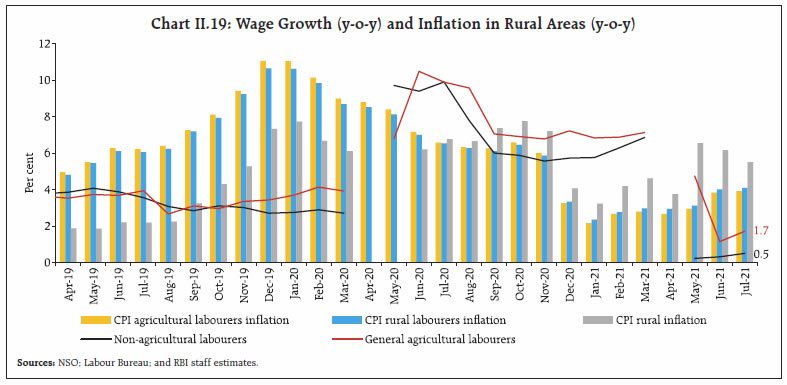  The firms covered in the Reserve Bank’s services and infrastructure outlook survey also expect input cost pressures as also the cost of finance to harden further going forward. The firms expect these factors to push up the selling prices in Q3 along with increase in salary outgoes (Chart II.21b). An analysis of the composition of costs among listed non-government non-financial (NGNF) firms18 reveals that there has been a distinct upward shift in costs for all constituents since the pre-pandemic period (Chart II.22). Manufacturing firms included in the purchasing managers’ index (PMI) also reported increase in input prices, with the pace of increase picking up in September 2021. PMI services firms reported elevated input prices, mainly driven by fuel, raw materials and transportation. In tandem, selling prices also started to tick up, though the pace remained muted. One year ahead business inflation expectations polled by the Indian Institute of Management, Ahmedabad, rose to their highest reading in July before softening somewhat in August.19 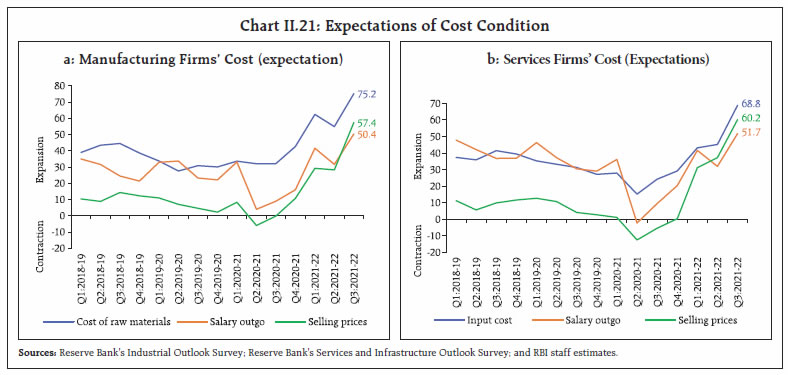 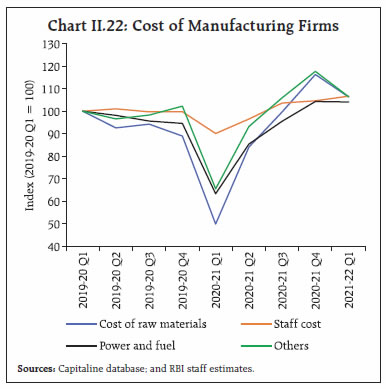 With inflation expected to moderate in near months, the outlook has improved, and its trajectory may be shifting downwards in contrast to initial expectations. Active supply-side interventions by the Government in food items, particularly in pulses and edible oils, should bring about a better balance between supply and demand. With cost pressures showing no sign of abating, core inflation remains sticky and elevated. Furthermore, shortage of key industrial components due to stretched global supply chains and logistics is also leading to cost escalation. As demand recovery gathers steam, there is a rising risk of higher input price pass-through to output prices. Measures to ameliorate supply-side cost pressures would be critical at this juncture, especially in terms of a calibrated reduction of the indirect taxes on petrol and diesel. This would help anchor inflation expectations, prevent build-up of a wage-price nexus and provide space for monetary policy to sustain support for the still incomplete growth recovery. __________________________________________________________________________________1 Headline inflation is measured by year-on-year changes in all-India consumer price index – combined (CPI-C). 2 CPI inflation for April-May 2021 was computed based on imputed CPI indices for April-May 2020. 3 Core CPI, i.e. CPI excluding food and fuel is worked out by eliminating the groups ‘food and beverages’ and ‘fuel and light’ from the headline CPI. 4 In May 2021, the market-wise price reporting fell to 68.1 per cent in rural areas (from 84.6 per cent in April 2021 and 89.1 per cent in March 2021) and 67.5 per cent in urban areas (from 87.4 per cent in April 2021 and 93.6 per cent in March 2021). 5 About 58 per cent of the domestic consumption of edible oil is imported. 6 A change in CPI year-on-year (y-o-y) inflation between any two months is the difference between the current month-on-month (m-o-m) change in the price index (momentum) and the m-o-m change in the price index 12 months earlier (base effect). For more details, see Box I.1 of the MPR, September 2014. 7 In view of the non-availability of CPI item level data for the period March-May 2020, the diffusion indices have been constructed with item level indices without seasonal adjustment. 8 The CPI diffusion index, a measure of dispersion of price changes, categorises items in the CPI basket according to whether their prices have risen, remained stagnant or fallen over the previous month. A reading above 50 for the diffusion index signals a broad expansion or generalisation of price increases and a reading below 50 signals broad-based price decline. 9 Historical decomposition estimates the contribution of each shock to the movements in inflation over the sample period (Q4:2010-11 to Q1:2021-22) based on a vector autoregression (VAR) with the following variables (represented as the vector Yt) – crude oil prices; exchange rate (INR per US$), asset price (BSE Sensex), CPI; the output gap; rural wages; the policy repo rate; and money supply (M3). All variables other than policy repo rate are growth rates. The VAR can be written in reduced form as: Yt =c + A Yt-1 + et; where et represents a vector of shocks. Using Wold decomposition, Yt can be represented as a function of its deterministic trend and sum of all the shocks et. This formulation facilitates decomposition of the deviation of inflation from its deterministic trend into the sum of contributions from various shocks. 10 The CPI weighting diagrams use the modified mixed reference period (MMRP) data based on the 2011-12 Consumer Expenditure Survey conducted by the National Sample Survey Office (NSSO). Under MMRP, data are collected on expenditure incurred for frequently purchased items – edible oil, eggs, fish, meat, vegetables, fruits, spices, beverages, processed foods, pan, tobacco and intoxicants – during the last seven days; for clothing, bedding, footwear, education, medical (institutional), durable goods, during the last 365 days; and for all other food, fuel and light, miscellaneous goods and services including non-institutional medical services, rents and taxes, data relate to the last 30 days. 11 Measured using words occurring in each news article, sentiments in this context can be construed to convey optimism (decrease) or pessimism (increase) about the price situation of a given commodity. For the analysis, a novel dataset of daily news items published in nine leading news dailies during 2016-2020 was constructed and filtered based on occurrence of keywords encompassing ‘supply’, ‘demand’ and ‘prices’ of TOP commodities. The framework laid down by Ardia et al. (2021) was used for sentiment computation and analysis. 13 Item level retail and wholesale prices sourced from the Department of Consumer Affairs (DCA) are aggregated at respective subgroup using item level CPI weights. Data for January-March 2021 have been excluded due to changes in price collection mechanism and item varieties by DCA. 14 The long-run relationship between headline CPI and WPI inflation has been disrupted by the pandemic and it holds only after controlling for the pandemic related disruptions. 15 Rural wages had increased sharply during May-June 2020 reflecting labour shortages during the nationwide lockdown period and the hike in wages by ₹20 under the Mahatma Gandhi National Rural Employment Guarantee (MGNREGA) scheme effective April 1, 2020. 16 Based on 1,647 manufacturing firms. 17 Based on 661 services firms. 18 Based on the abridged quarterly financial results of common companies. 19 The monthly Business Inflation Expectations Survey (BIES) of the Indian Institute of Management, Ahmedabad, polls a panel of around 1200 business leaders primarily from the manufacturing sector about their inflation expectations in the short and medium term. The latest survey pertains to July 2021. While the second wave dented the momentum of economic activity in Q1:2021-22, its impact on aggregate demand was muted relative to the first wave. Aggregate demand recovered in Q2:2021-22 and is expected to strengthen further in H2. The supply side is gradually normalising with the easing of supply chain and logistic disruptions. The recovery, however, remains dependent upon continued policy support, the COVID-19 trajectory and the progress of vaccination. Within days of the release of April 2021 MPR, the second wave of COVID-19 intensified and became virulent and lethal, overwhelming the health infrastructure and denting the momentum of economic activity in Q1:2021-22. The second wave receded as rapidly as it had surged (Chart III.1). Accordingly, the impact on aggregate demand was muted and short-lived relative to the first wave. More nuanced and calibrated containment measures and adaptation by businesses and households to working in a pandemic environment also moderated the headwinds from the second wave. Aggregate demand recovered further in Q2:2021-22, led by investment and private consumption. 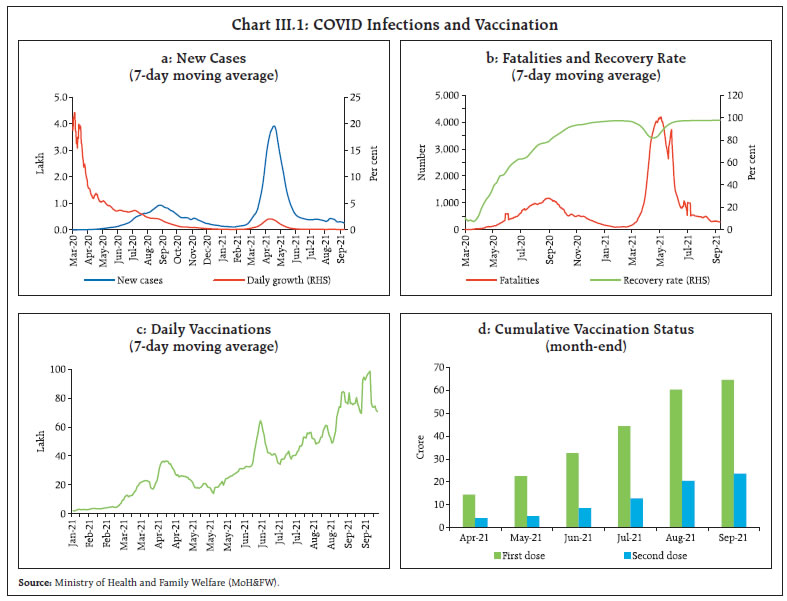 The recovery is benefitting from pent-up demand supported by the increasing vaccination coverage, the government’s push towards capital expenditure, robust external demand and normal monsoon. The ongoing demand revival is expected to get a further boost from the government’s asset monetisation programme and reforms encompassing the telecom and banking sectors. The supply side is also gradually normalising with the easing of supply chain and logistic disruptions. Agriculture and allied activities remain resilient, backed by above normal kharif sowing. A number of high-frequency indicators are yet to exceed the pre-COVID levels, however, and the recovery remains dependent upon continued policy support. Despite a loss of momentum in the wake of the severe second wave, real gross domestic product (GDP) rose by 20.1 per cent year-on-year (y-o-y) in Q1:2021-22 on a large favourable base effect (Table III.1 and Chart III.2a), supported by expansion in all its constituents except for government final consumption expenditure (GFCE) which contracted. The level of GDP in Q1:2021-22 was, however, still 9.2 per cent below the pre-pandemic (Q1:2019-20) level. Excluding GFCE, real GDP expanded by 25.0 per cent (y-o-y) during Q1. Momentum – the quarter-on-quarter (q-o-q) seasonally adjusted annualised rate (SAAR) of real GDP – fell during Q1:2021-22, however, reflecting the lockdowns/restrictions during the second wave, although the contraction was lower than a year ago with businesses and households adapting better to COVID-19 protocols as well as the sharp tapering in infections (Chart III.2b). Aggregate demand gained momentum in Q2, supported by recovery in private consumption and investment demand. 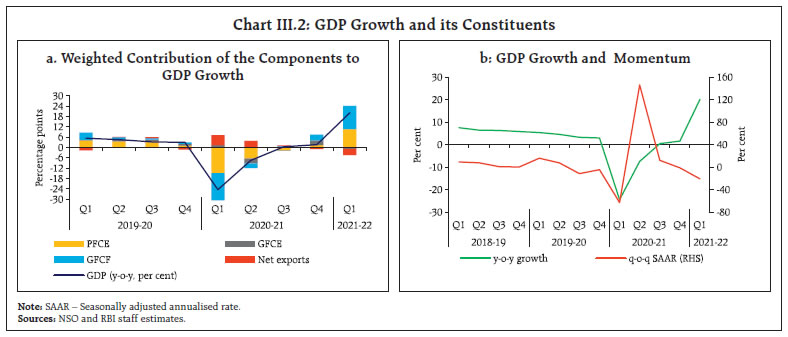 GDP Projections versus Actual Outcomes Actual real GDP growth of 20.1 per cent in Q1 undershot the April 2021 MPR projection of 26.2 per cent (Chart III.3), largely reflecting the impact of the steep jump in infections due to the second wave. The April MPR had alluded to the potential surge in infections and new mutants as downside risks to the baseline growth path. The decline in the government consumption expenditure also contributed to actual GDP growth trailing projections. 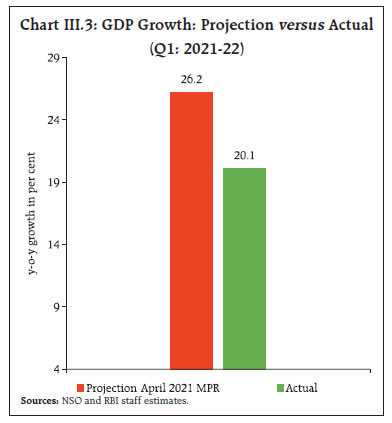 III.1.1 Private Final Consumption Expenditure Private consumption, with a share of around 55 per cent in GDP during Q1:2021-22, continued as the mainstay of aggregate demand. Notwithstanding a y-o-y growth of 19.3 per cent, it was around 12 per cent lower than its pre-COVID level (Q1:2019-20). The accelerated pace of vaccination and the plateauing of new infections are facilitating faster resumption of contact-intensive services and giving a fillip to private consumption. Urban demand is turning the corner as corroborated by high frequency coincident and leading indicators for Q2. Passenger vehicle sales in July and August crossed pre-COVID levels (Chart III.4a), but production is facing headwinds from the persistence of global supply bottlenecks in the availability of semiconductor chips. Domestic air passenger traffic and the production of consumer durables regained traction during July and August, albeit they are still below pre-COVID levels (Chart III.4b and c). Household credit is gradually improving, driven by credit card transactions and personal loan, supporting consumer durables financing (Chart III.4d). Digital retail payments data, which provide useful signals of economic activity, corroborate the upturn (Box III.1). Rural consumption demand, which was largely immune to the pandemic during the first wave, was dented during the second wave with the fast spread of infections to rural areas. With the abatement of the second wave and improving vaccinations, rural consumption exhibited recovery in Q2, backed by buoyant rabi harvest, good kharif prospects, government transfers and the Mahatma Gandhi National Rural Employment Guarantee Act (MNREGA) programme. The pick-up in motorcycle sales during June-August and the improvement in consumer non-durables underscore this revival (Chart III.5). Tractor sales have exhibited robust growth, remaining above their pre-pandemic levels, although sales dipped in August in the usual seasonal pattern. Fertiliser sales picked up from May, moving in tandem with 2019 levels, although trailing the exceptionally strong growth of last year.  Unemployment rose and labour force participation fell in Q1:2021-22 under the pressure of the second wave, but the impact was muted compared to the first wave. According to the Centre for Monitoring Indian Economy (CMIE), there was a deep hit to labour markets in mid-May at the peak of the second wave. Employment recovered swiftly in June-July and strengthened in September (Chart III.6a). In September, labour participation further rose with the phased opening up of the economy leading to rising demand for labour. Employment conditions improved in June and July 2021 in the organised sector, according to payrolls data (Chart III.6b). Increase in hirings is led by the IT sector, while non-IT sectors such as education, banking, financial, insurance, hospitality and automobile sector have also shown strong recovery recently, according to Naukri Jobspeak data.
 III.1.2 Gross Fixed Capital Formation Gross fixed capital formation (GFCF) expanded by 55.3 per cent (y-o-y) in Q1 (contraction of 46.6 per cent a year ago). Sequentially, there was a dip of 23.6 per cent in Q1 despite robust government capex. The share of GFCF in aggregate demand inched up to 31.6 per cent in Q1 from 24.4 per cent a year ago but remained lower than its pre-pandemic level. Construction activity, a large portion of GFCF, was subdued due to pandemic effects, especially led by labour and materials shortages, although the impact was less than during the first wave. There are signs of revival in investment demand in Q2, as suggested by the movements in the proximate indictors – capital goods imports; production of capital goods; and cement production (Charts III.7). 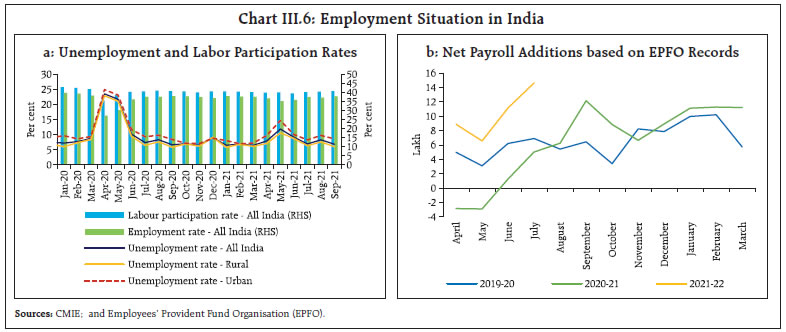 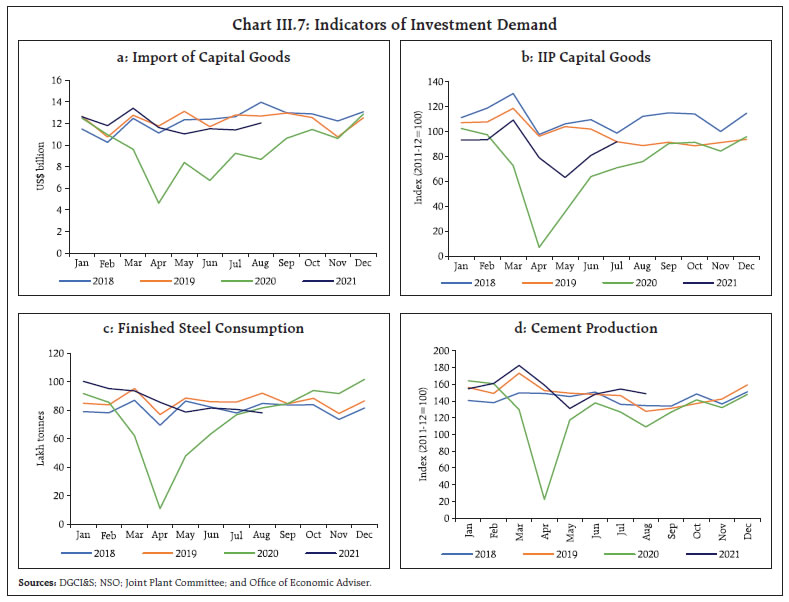 Capacity utilisation (CU) in the manufacturing sector dropped to 60.0 per cent in Q1:2021-22 from 69.4 per cent in the previous quarter (Chart III.8). On a seasonally adjusted basis, CU fell from 66.7 per cent in Q4 to 61.7 per cent in Q1. The interest coverage ratio (ICR)2 of listed non-financial private companies in the manufacturing and information technology (IT) sectors improved further in Q1:2021-22, indicating improved debt servicing capacity and hence, conducive conditions for the expansion in investment activity (Chart III.9). The production-linked incentive (PLI) scheme is nurturing private investment. The mega schemes, viz. National Infrastructure Plan (NIP) amounting to ₹100 lakh crore and National Monetisation Pipeline (NMP) involving ₹6 lakh crore (Chart III.10), are also expected to give a major thrust to infrastructure spending and uplift potential output. The NMP, which will be co-terminus with the balance NIP period (2021-22 to 2024-2025), is expected to unlock the value of investments in brownfield public sector assets by tapping institutional and long-term capital and by leveraging further public investments. The central government’s financial assistance to the state governments for infrastructure spending and incentives for disinvestment/monetisation in the form of additional allocation equivalent to 33 per cent of value of the monetised assets, subject to the realised amount being used for capital expenditure, should also provide an impetus to capital expenditure. 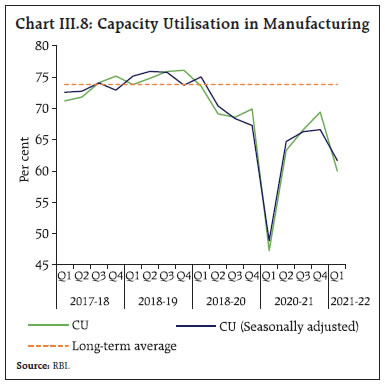  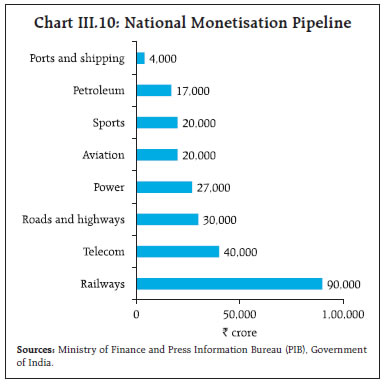 III.1.3 Government Expenditure Government final consumption expenditure (GFCE) contracted by 4.8 per cent in Q1:2021-22, partly due to the base effect. Revenues – both tax and non-tax – remained robust. The fiscal position of the central government accordingly strengthened during April-August 2021 and the gross fiscal deficit (GFD) and the revenue deficit (RD) at 31.1 per cent and 27.3 per cent of the budget estimate (BE), respectively, were lower than past trends (Table III.2). Though the first supplementary demands for grants for 2021-22 presented in July involved gross additional expenditure of ₹1,87,202 crore, the net cash outgo amounts to only ₹23,675 crore or 0.12 per cent of GDP. The buoyancy in the central government’s tax revenue during April-August 2021 was driven by higher corporate taxes (on the back of strong corporate performance) and customs duties (due to higher import demand and improving trade activity) (Table III.3). Excise duty collections benefitted from higher global crude oil prices. Goods and services tax (GST) collections received a jolt from the second wave during May and June but recovered rapidly in the subsequent period (Chart III.11). Overall, direct taxes rose by 101.4 per cent y-o-y (32.8 per cent over the corresponding period of 2019-20), while indirect taxes surged by 52.5 per cent (27.2 per cent over the corresponding period of 2019-20). Non-tax revenue also registered healthy growth, boosted by higher surplus transfer by the Reserve Bank. 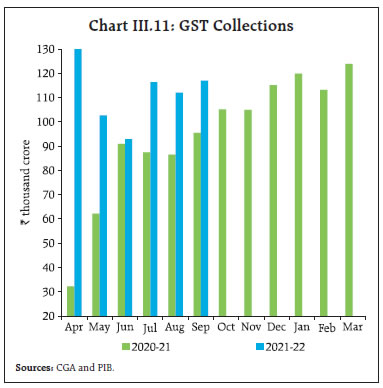 On the expenditure side, revenue expenditure contracted marginally by 0.8 per cent y-o-y during April-August 2021 (although higher by 6.3 per cent over the pre-pandemic level), partly due to the frontloading of expenditures a year ago necessitated by the first wave of the pandemic and also efforts to curtail avoidable spending. Spending on major subsidies, however, increased by 12.8 per cent y-o-y (lower by 22.2 per cent compared to the same period of 2019-20), with the extension of the schemes put in place last year to provide free ration to more than 80 crore people under the Pradhan Mantri Garib Kalyan Anna Yojana to mitigate the impact of COVID-19. The central government’s capital expenditure increased by 27.8 per cent y-o-y during April-August 2021 (and 26.2 per cent over pre-COVID level), driven by outlays towards road transport and highways. 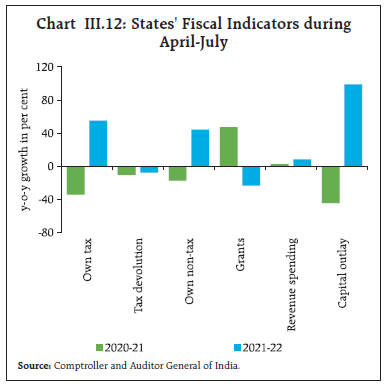 Available information for 18 states indicates that their GFD in April-July 2021 (as per cent to full year budget estimates) was lower than a year ago on the back of a surge in revenue receipts led by own tax and non-tax revenues, even as transfers from the Centre contracted (Chart III.12).3 Subsequent to the 43rd meeting of the GST Council, it was decided that the Centre would borrow ₹1.59 lakh crore from the market through a special window for 2021-22, which would be passed on to states as back to back loans; of this, an amount of ₹75,000 crore has been transferred to states. Furthermore, ₹81,179 crore of the GST compensation overdues of the last year are also expected to be transferred this year. Both revenue and capital expenditure of the states picked up during April-July 2021 – the latter expanded sharply by 99 per cent, more than offsetting the contraction of 45 per cent a year ago. The Union Budget 2021-22 projected gross and net market borrowings at ₹12.05 lakh crore and ₹9.24 lakh crore, respectively. The centre’s gross issuances of market borrowings during the first half were ₹7.02 lakh crore (58.3 per cent of the full year budgeted amount) as against ₹7.24 lakh crore envisaged in the calendar for H1 (Table III.4). The weighted average cost and maturity of issuances during H1:2021-22 were 6.19 per cent and 16.7 years, respectively (5.8 per cent and 14.8 years in the same period of 2020-21). For H2:2021-22, the centre’s gross market borrowings have been planned ₹5.03 lakh crore in line with the full year budget estimates. Against the backdrop of comfortable cash position, the Central Government has not planned additional market borrowing for making payment to the state governments for GST compensation. States raised gross market borrowings of ₹3.09 lakh crore during H1:2021-22, 83.4 per cent of the indicative calendar. The ways and means advances (WMA) limit for the Central Government for H1:2021-22 was scaled back to ₹1.2 lakh crore from ₹2 lakh crore in H1:2020-21; for H2:2021-22, it has been fixed at ₹0.5 lakh core as compared with ₹1.25 lakh core a year ago. For states/union territories, the Reserve Bank decided to continue with the enhanced interim WMA limit of ₹51,560 crore during the first half of 2021-22 to help them in tiding over the short-term mismatches and difficulties faced due to the pandemic. III.1.4 External Demand Buoyed by strong external demand and base effects, exports registered a sharp expansion in Q1:2021-22 and the buoyancy continued to Q2 (Chart III.13). Merchandise imports also rebounded strongly on the back of the recovery in domestic demand, higher crude oil prices and base effects. With the growth of imports outpacing that of exports, net exports contributed negatively to aggregate demand in Q1:2021-22 [(-)1.9 per cent in Q1 as compared with 1.3 per cent a year ago and (-) 4.8 per cent two years ago (pre-COVID)]. The surge in merchandise exports was powered by engineering goods, petroleum products, organic and inorganic chemicals, cotton textiles and drugs and pharmaceuticals. Labour-intensive sectors like apparels, leather products and tea continue to lag, mainly due to their greater sensitivity to mobility restrictions (Chart III.14). Going forward, the schemes such as District as Export Hub (DEH) covering One District One Product (ODOP), PLI scheme for sunrise sectors and Ubharte-Sitaare scheme for MSMEs should improve export competitiveness and help to achieve the target of US$ 400 billion set for 2021-22. The persistent upsurge in global container freight prices and the growing shortage of semi-conductors, however, pose downside risks to a durable merchandise trade recovery (see Chapter V). 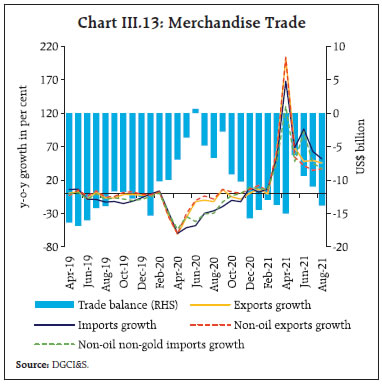 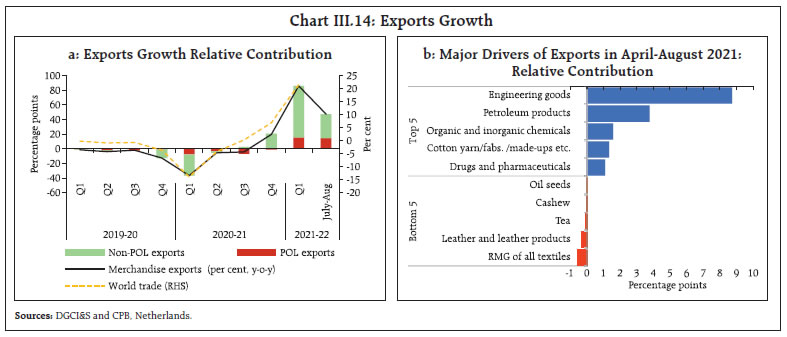 The impact of the second wave on import demand remained limited as compared to the first wave, reflecting calibrated and localised restrictions and businesses adapting to COVID-appropriate working environment. In Q2, with the gradual unwinding of restrictions, merchandise imports spurted and exceeded pre-COVID levels. Non-oil non-gold imports were led by higher shipments of pearls and precious stones, vegetable oils, chemicals and chemical products. Gold imports, after dropping sharply in May and June on the back of subdued demand due to the second wave, revived in Q2 with the relaxations of the restrictions (Chart III.15). The trade deficit widened to US$ 55.5 billion in April-August 2021 from US$ 23.4 billion a year ago, but it remained below its pre-COVID level (US$ 77.2 billion). Services exports growth in Q1: 2021-22 was the highest in 13 quarters and surpassed pre-pandemic levels (Chart III.16). This strong growth in the overall services exports was driven by software, business, and transportation services. Major information technology (IT) companies continued to benefit from pandemic-induced demand from international customers and adoption of new models. They recorded solid revenue growth in Q1:2021-22, driven by banking, financial services including insurance, communications, healthcare and technology services. As a result, resilient services surplus had a favourable impact on the current account balance in Q1:2021-22. During Q2 (July-August 2021), double-digit growth in services exports was driven by software, business and transport services. Turning to the financial account, capital flows remained healthy during Q1:2021-22, primarily due to foreign direct investment (FDI), which was driven by a few big deals in the manufacturing and digital sectors (Chart III.17). Net FDI at US$ 14.1 billion in April-July 2021 was higher than a year ago. While foreign portfolio investors (FPIs) adopted a cautious stance during the second wave of COVID-19, they turned net buyers from August 2021 amidst robust Q1 corporate earnings and better domestic macroeconomic indicators. Accretions to non-resident deposits moderated during April-July 2021 as compared with a year ago. As on October 1, 2021, India’s foreign exchange reserves stood at US$ 637.5 billion, equivalent to 14 months of imports projected for 2021-22 and 111.6 per cent of outstanding external debt at end-June 2021.  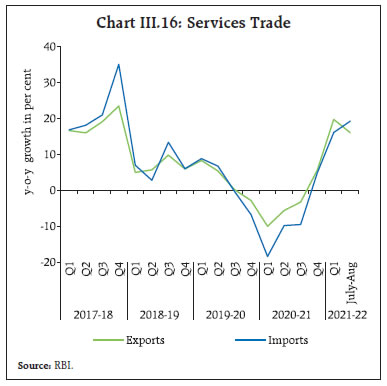 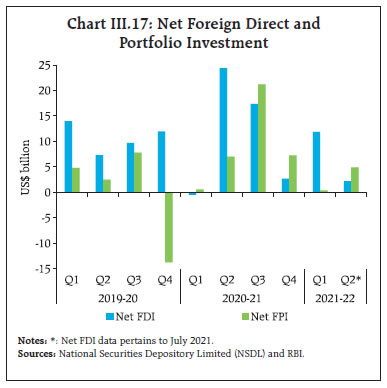 Real gross value added (GVA) at basic prices rose by 18.8 per cent y-o-y during Q1:2021-22 as against a contraction of 22.4 per cent in Q1:2020-21 (Table III.5). The resilience of agriculture and the recovery in manufacturing and non-contact intensive services supported the expansion in GVA, while contact-intensive services lagged due to logistic and operational constraints. Real GVA was, however, 7.8 per cent below its pre-pandemic (Q1:2019-20) level. III.2.1 Agriculture Agriculture and allied activities registered robust growth in Q1:2021-22 on the back of record rabi and horticulture production and resilience in allied activities. Foodgrains production rose by 3.7 per cent in 2020-21, led by rice and wheat (Table III.6). The production of nine major oilseeds increased by 8.7 per cent, supported by the implementation of area expansion policies under the National Food Security Mission for edible oils. Horticulture production rose by 2.9 per cent during 2020-21, led by an increase of 2.8 per cent in the area under cultivation. In 2021, the south-west monsoon rainfall encountered two slowdown phases (from the third week of June to mid-July and almost the whole of August), after a normal start. With the strong revival of rains in September, the cumulative seasonal rainfall was 0.7 per cent below the long period average (LPA), with 83 per cent of the sub-divisions receiving normal or above normal rainfall (Charts III.18a and b). The production weighted rainfall (PRN) index at 102 per cent (as on September 30) was below last year’s position (105 per cent) and the PRN for rice, coarse cereals and sugarcane exceeded the 5-year average. As on September 30, 2021, reservoir levels stood at 80 per cent of the full reservoir level (FRL), higher than the decadal average of 77 per cent – brightening the prospects for the ensuing rabi season (Chart III.18c). Despite the breaks in the monsoon’s progress, kharif sowing progressed well. As on September 30, 2021 it was 0.2 per cent above the record sowing acreage a year ago, and 4.1 per cent higher than the normal sown area (5-year average) (Chart III.18d). Higher minimum support prices (MSPs) – with increases of 1.1 per cent to 6.6 per cent over the previous year for kharif 2021-22 with assured return of at least 50 per cent over the cost of production (as measured by A2 plus FL) – supported sowing activity. According to the first advance estimates for 2021-22, the production of kharif foodgrains rose by 0.6 per cent over last year (Table III.7). The Government of India had set the target for foodgrains production for the year at 3,070 lakh tonnes in the National Kharif Strategy for 2021-22 which, inter alia, aims to attain self-sufficiency in the production of pulses and oilseeds. 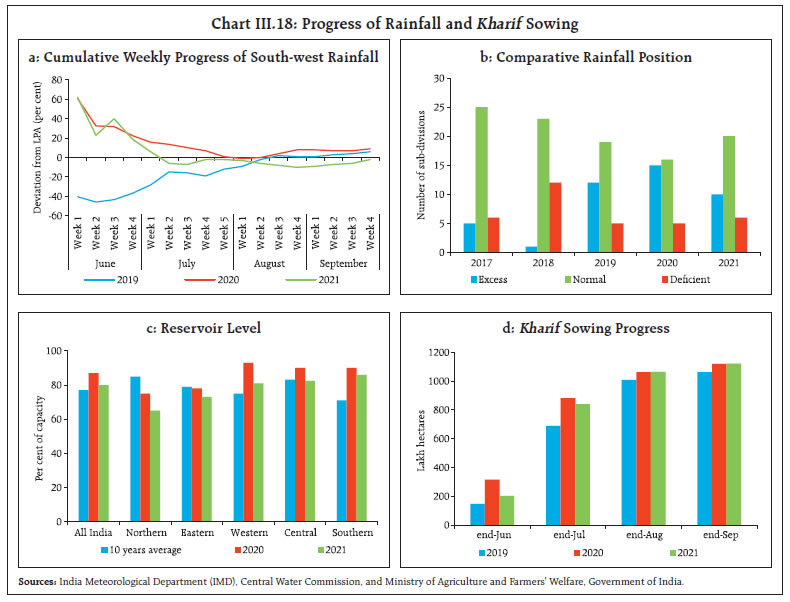 Improved rural prospects from kharif sowing are mirrored in high frequency indicators, viz., sales of tractors and two-wheelers (Table III.8). Exports of agriculture and allied products also expanded. III.2.2 Industry Industrial GVA posted y-o-y growth of 40.4 per cent in Q1:2021-22, aided by a favourable base effect (31.0 per cent contraction last year). On a sequential basis, industrial output contracted by 11.8 per cent in Q1, reflecting the loss of momentum in the face of the second wave. Industrial GVA trailed 3.1 per cent below its pre-pandemic level (Q1:2019-20); while mining and manufacturing remained below Q1:2019-20 levels, electricity, gas, water supply and other services exceeded Q1:2019-20 levels by 3.0 per cent (Chart III.19). The index of industrial production (IIP) rose by 44.7 per cent y-o-y during Q1:2021-22 on a negative base but remained 6.7 per cent below its level two years back. In Q2, the IIP expanded by 11.5 per cent y-o-y in July 2021, although it trailed marginally the pre-pandemic levels (July 2019). Sequentially, the IIP expanded in June-July after moderating in April and May. In terms of the use-based classification, all sectors except for consumer durables exceeded 2019-20 levels by July (Chart III.20). Manufacturing activity dipped in May but gained momentum in June-July. The production of motor vehicles, trailers, machinery equipment, electrical equipment, textiles and beverages supported IIP growth in July. 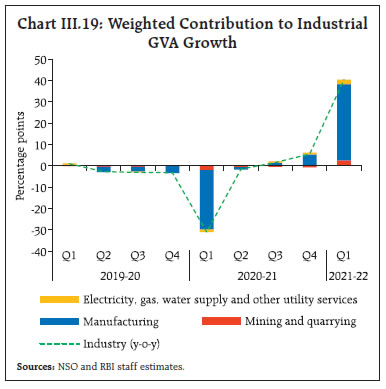 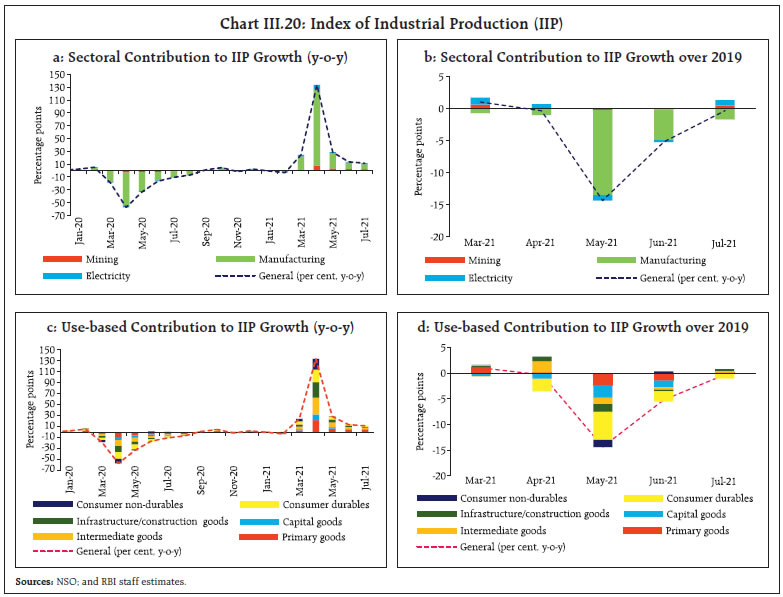 Manufacturing activity is expected to be boosted by the PLI scheme for 13 sectors, aimed at creating global manufacturing champions for an AtmaNirbhar Bharat, with an outlay of about Rs. 1.97 lakh crore over 5 years. The PLI scheme, implemented across ten sectors so far (Chart III.21), can improve the manufacturing sector’s global competitiveness and participation in the global supply chain, giving impetus to domestic production, exports, investment in cutting edge technology, innovations and employment opportunities by establishing linkages with the MSME sector. 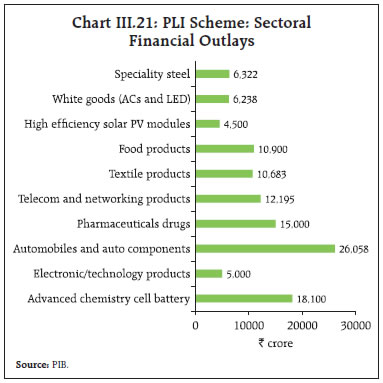 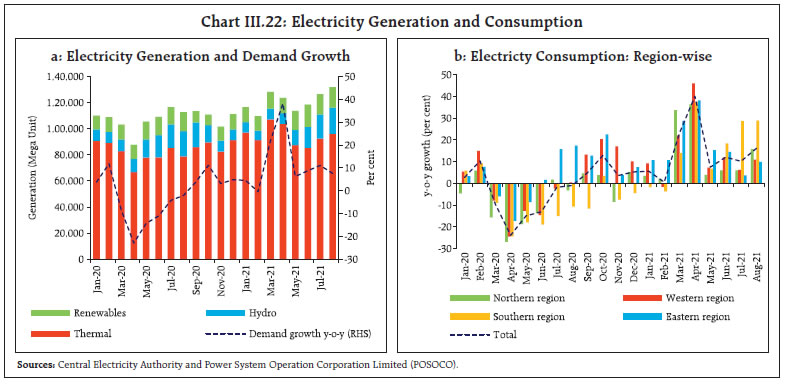 Electricity generation improved substantially in Q1:2021-22 on a y-o-y basis but remained below 2019-20 levels. Thermal and renewable sources expanded y-o-y by 24.1 per cent and 12.9 per cent, respectively, with the latter surpassing 2019-20 levels. In Q2, the electricity generation expanded by 1.6 per cent and 15.8 per cent, respectively, in July and August, with hydro and thermal power generation also exceeding pre-pandemic levels (Chart III.22a). Electricity consumption rose across the country in July and August, with base effects leading to faster growth in some regions (Chart III.22b). Competition and efficiency in electricity distribution should accrue from the Electricity Amendment Bill 2021 which aims to delicense electricity distribution and allow entry of private players. The buoyant y-o-y expansion in nominal GVA of manufacturing in Q1 was supported by strong corporate profitability (Chart III.23). Apart from the base effect, the substantial contraction in interest expenses on the back of easy financial conditions contributed to the surge in profitability, even as employee costs and operating expenses posted an uptick. According to the Reserve Bank’s industrial outlook survey, the manufacturing sector’s sentiments rebounded in Q2:2020-21, with the business assessment index improving to 116.7 in Q2:2021-22 from 89.7 in Q1:2021-22. For Q3:2021-22, respondents expect further improvement in production volumes, new orders and job landscape. The manufacturing purchasing managers’ index (PMI) remained in expansion zone at 53.7 in September, driven by strengthening demand conditions (Chart III.24a). 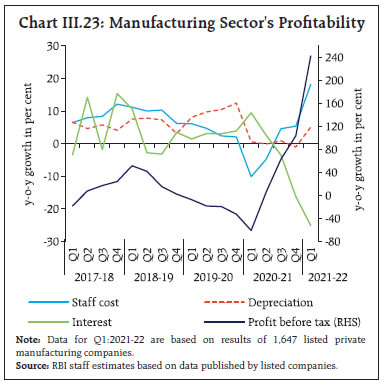 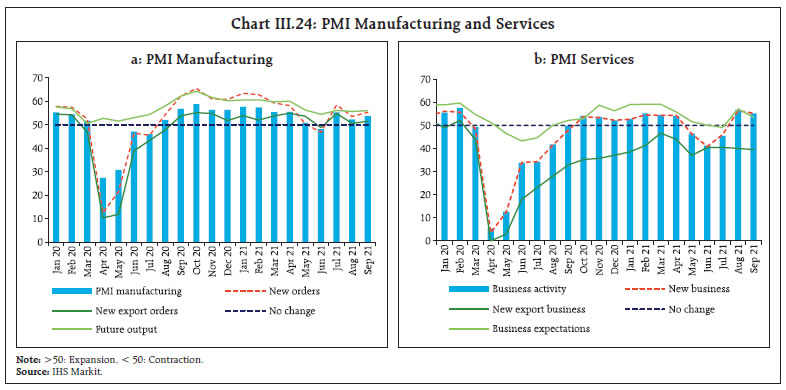 Overall, the manufacturing activity is gradually normalising with the waning of the second wave (Table III.9). Consumer non-durables, surpassed the pre-COVID levels during June and remained strong in Q2, while infrastructure and primary goods, steel, and cement made progress towards normalisation in June and surpassed pre-pandemic level in Q2.  III.2.3 Services The second wave impacted the services sector in a disproportionately high manner in view of the blow to contact-intensive services. Services contracted by double digits sequentially in Q1:2021-22, interrupting the recovery from the first wave. On a y-o-y basis, however, the services sector expanded by 16.1 per cent in Q1:2021-22 driven by a favourable base effect. With the retreating of the second wave, services regained momentum in Q2 as shown by high frequency indicators, and contact-intensive services began mending with the gradual easing of restrictions and the accelerated pace of vaccination (Table III.9). GST collections and issuances of e-way bills – indicators of wholesale and retail trade – revived to pre-pandemic levels from June/July onwards, suggesting strengthening domestic trading activity. Some revival in discretionary spending and pent-up demand are also boosting trading activity and e-commerce. In the construction sector, cement production rose further while finished steel consumption moderated in August (Chart III.25). Transportation services remained relatively upbeat during Q1 and gained further in Q2 with the gradual unwinding of the regional lockdowns. Railway freight traffic remains above pre-COVID levels and posted a robust growth of 16.9 per cent in August, while port cargo traffic reached its pre-pandemic level in August. Toll collections in Q1 and Q2 have stayed above the pre-pandemic levels due to a greater use of FASTag (Table III.9). Commercial vehicle sales – an indicator of transportation services – almost halved sequentially in Q1, but there are reports of an uptick in sales in Q2. The aviation sector displayed segmentation, with passenger traffic lagging cargo traffic considerably. Domestic air passenger traffic is, however, gaining traction with the lifting of the restrictions and increasing confidence. The communication services performed well in Q1 and Q2, driven by pandemic-induced digitisation of the economy. Despite the strong performance of information technology and financial companies, GVA in financial, real estate and professional services posted a subdued growth of 3.7 per cent in Q1 and moderated substantially over the preceding quarter as businesses in other segments faltered due to mobility related restrictions. Some recovery, however, was seen in the travel and hospitality industries, real estate and other contact-intensive professional services in Q2. Growth in aggregate deposits remained buoyant and bank credit recorded some improvement, extending support to financial services during Q2. Real estate activity dampened in Q1 as new launches and sales were hampered by the lockdowns. The inventory overhang stagnated at an average of 58 months in Q1 (Chart III.26a). All-India housing prices, according to the RBI’s index, showed a deceleration in Q1:2021-22, dragged down by Bengaluru, Chennai and Delhi (Chart III.26b). 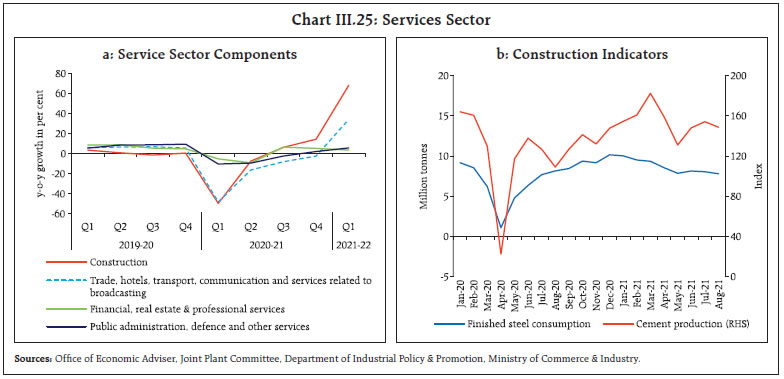 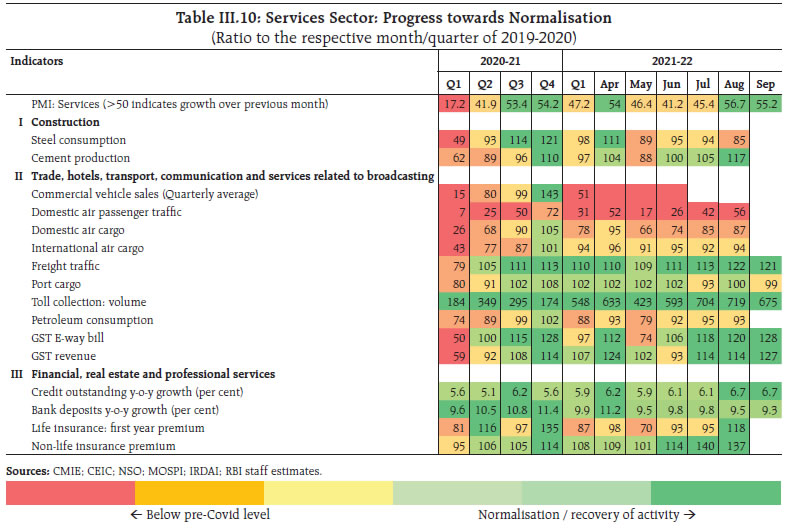 Public administration, defence and other services (PADO) expanded moderately in Q1:2021-22 on a y-o-y basis. The central government’s revenue expenditure, excluding interest payments and subsidies, contracted in Q1 on an unfavourable base while that of state governments posted a double-digit growth. Other services in PADO – private education; heath; personal services; and cultural and recreational activities – remained tepid. In August and September, the PMI services re-entered the expansion zone reversing the second wave induced contraction of May-July (Chart III.24b). The PMI composite output index rose to 55.3 in September from 49.2 in July.  The momentum of economic activity was interrupted during Q1:2021-22 by the second wave. Aggregate demand began reviving in June and gained momentum in Q2. It is expected to strengthen further in H2 with the recovery in both urban and rural consumption. On the supply side, agriculture and allied activities should benefit from the good kharif sowing and harvest. Rabi sowing and total crops production are expected to be well-supported by improving water storage in reservoirs and the early announcement of minimum support prices for the ensuing rabi season. The recovery in manufacturing and services activities, including contact-intensive services, in H2 should get a fillip from the growing proportion of the inoculated population, further normalisation of supply chains, congenial financing conditions and the government’s infrastructure and asset monetisation push. The outlook, however, remains critically dependent upon the evolution of COVID-19’s trajectory and the progress of vaccination to cover the rest of the population. __________________________________________________________________________________ 1 Unit root tests suggest that all variables are non-stationary (I(1)). Bounds test (F-statistics) confirm cointegration for all the specifications at 5 per cent significance level. Data are in log terms and adjusted for seasonality; the variable lags are based on the Bayesian information criterion (BIC) and the regression diagnostics are satisfied. 2 Interest coverage ratio is the ratio of earnings before interest and taxes (EBIT) to interest expenses and measures a company’s capacity to make interest payments on its debt. 3 Following the deterioration in key fiscal indicators in 2020-21, 27 states budgeted a lower consolidated GFD at 3.4 per cent of GDP for 2021-22, driven by higher revenues. IV. Financial Markets and Liquidity Conditions During H1:2021-22, domestic financial markets remained vibrant amidst easy liquidity conditions, notwithstanding the ravages unleashed by the virulent second wave of the pandemic in April-May 2021. Monetary transmission improved further, due to abundant liquidity and forward guidance by the MPC of continuing with the accommodative stance. Going forward, liquidity conditions would continue to be accommodative in consonance with the monetary policy stance through calibrated liquidity management operations. Global financial markets remained exuberant through most of H1:2021-22, buoyed by a surfeit of liquidity, ultra-accommodative monetary policies in major advanced economies (AEs) and forward guidance promising continuation of these policies. Investor optimism has caused valuations across a range of assets to be elevated. Stock markets scaled peaks repeatedly in most AEs and select emerging market economies (EMEs), with intermittent bouts of corrections sparked by the rapid spread of the Delta variant of COVID-19. Bond yields softened in AEs as markets increasingly acquiesced with central banks that inflationary pressures are transient and would not trigger normalisation. In EMEs, bond yields experienced two-way movements, with phases of hardening in response to the uncertainty over the timing and pace of tapering of asset purchases by the US Federal Reserve. In currency markets, the US dollar strengthened from May 2021 on better economic prospects and consequently, some EME currencies depreciated while others faced appreciation pressures because of carry trade and search for returns. IV.1 Domestic Financial Markets During H1:2021-22, domestic financial markets remained vibrant amidst easy liquidity conditions, notwithstanding the ravages unleashed by the virulent second wave of the pandemic in April-May 2021. Large liquidity injections, including through the secondary market acquisition programme of government securities (G-SAP), ensured orderly conditions in financial markets. Concerns about a possible third wave, uncertainty over the path of the US Fed’s tapering of asset purchases, elevated inflation, and the large government borrowing programme kept market sentiments edgy. IV.1.1 Money Market Money market rates consistently traded below the reverse repo rate – the lower bound of the liquidity adjustment facility (LAF) corridor – during H1:2021-22 (Chart IV.1). The weighted average call rate (WACR) – the operating target of monetary policy – traded 17 basis points (bps) below the floor of the corridor on an average during H1. With the Reserve Bank becoming the major counterparty for banks, there was a shrinkage in inter-bank trading activity – average daily volume in the call money market declined to ₹7,381 crore in September 2021 from ₹10,126 crore in March 2021.  In the overnight call money segment, the weighted average rate (WAR) of traded deals generally remained above the reverse repo rate while that on reported deals1 remained below the reverse repo rate, reflecting market segmentation as small co-operative banks – principal lenders in reported deals – do not have the requisite information technology (IT) infrastructure to access the Negotiated Dealing System - Call (NDS-Call) and usually lend bilaterally towards the close of market hours at lower rates. The share of the reported deals in total volumes in the call money segment increased to 60 per cent in H1:2021-22 from 54 per cent in H2:2020-21 (Chart IV.2), driven by a rise in lending by co-operative banks from 65 per cent of the total volume of the call money segment to 80 per cent over the same period. The surplus liquidity conditions also led to a diminishing share of the uncollateralised segment in total overnight money market volume – from 6.0 per cent in February 2020 (pre-pandemic) to 2.0 per cent in September 2021. In the collateralised segment, the share of triparty repo in total overnight money market volume increased to 74 per cent in September 2021 from 72 per cent in March 2021 while the share of market repo declined to 24 per cent from 26 per cent during the same period (Chart IV.3). Mutual funds, the major lenders in both the collateralised segments, increased their participation further in H1 from 68 per cent to 70 per cent in the triparty repo segment and from 61 per cent to 63 per cent in market repos. On the borrowing side, there was an increase in the share of private banks in both the secured segments – from 24 per cent in March 2021 to 25 per cent in September 2021 for triparty repo and from 13 per cent to 14 per cent for market repo.  The rates in the secured overnight segments remained consistently below the reverse repo rate during H1:2021-22 on surplus liquidity (Chart IV.4). Interest rates on longer-term money market instruments like 91-day Treasury Bills (T-bills) and 3-month certificates of deposit (CDs) traded marginally above the reverse repo rate, on average, by 1 bp and 8 bps, respectively during H1:2021-22. Issuance of CDs increased to ₹56,658 crore during H1:2021-22 from ₹45,165 crore in the corresponding period of 2020-21, reflecting congenial financing conditions.  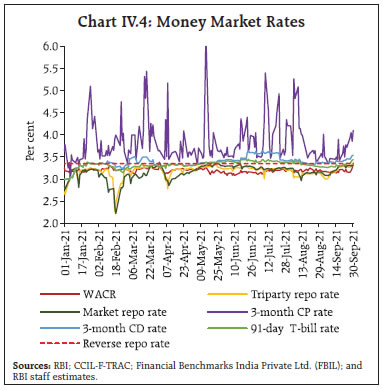 Riding on the surplus liquidity conditions, commercial paper (CP) issuances increased substantially to ₹10.1 lakh crore during H1:2021-22 from ₹7.9 lakh crore during the corresponding period of 2020-21 (Chart IV.5a). CP rates generally traded above the reverse repo rate, with an average spread of 46 bps during H1:2021-22. The weighted average discount rate (WADR) firmed up in July 2021 due to increased issuances by non-banking financial companies (NBFCs), partly to mobilise resources for investment in initial public offerings (IPOs), but moderated subsequently. The share of NBFCs in total CP issuances increased to 43.2 per cent in H1: 2021-22 from 21.9 per cent in the corresponding period of the previous year while that of corporates moderated to 46.2 per cent from 64.9 per cent over the same period (Chart IV.5b). 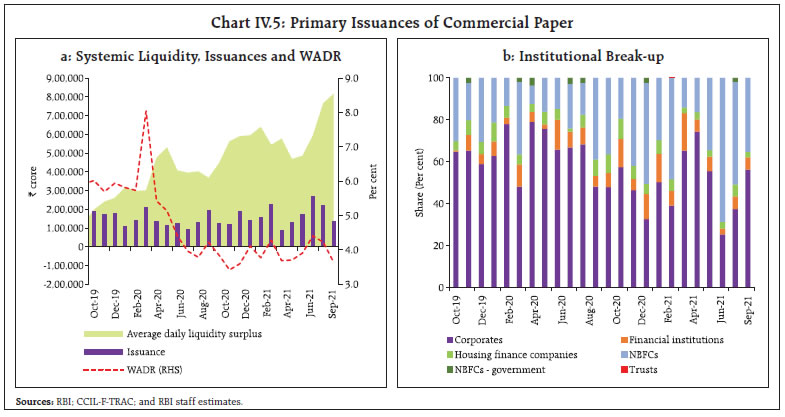 IV.1.2 Government Securities (G-sec) Market During H1:2021-22, the 10-year G-sec yield softened by 11 bps, aided by a host of measures taken by the Reserve Bank to foster an orderly evolution of the yield curve. During April-May 2021, the 10-year G-sec yield softened by 6 bps on (i) the monetary policy committee (MPC) continuing with its accommodative growth-supportive stances; (ii) the announcement of G-SAP 1.0 of ₹1 lakh crore for Q1; and (iii) special OMOs (operation twist) of ₹10,000 crore, although fears of additional government borrowing to bridge the GST compensation cess shortfall imparted transient bearishness to market sentiment. Yields hardened in June by 8 bps over elevated May inflation print and higher crude oil prices. Overall, however, the 10-year yield remained range bound during Q1:2021-22. In Q2, the 10-year yield initially declined to 6.13 per cent on July 15, 2021 aided by a lower than expected CPI inflation print for June and issuance of a new 10-year benchmark security at a coupon of 6.10 per cent (Chart IV.6). In August, however, yields hardened by 5 bps in reaction to the MPC’s inflation forecast being revised upwards above expectations and fears of liquidity tightening on the announcement of a calendar for an enhanced scale of variable rate reverse repo (VRRR) auctions. In the first half of September, yields softened as these apprehensions were allayed, along with (i) the resumption of portfolio debt inflows; (ii), lower than expected fiscal deficit of the central government for April-July; and (iii) a softer CPI inflation print. Yields, however, firmed up during the second half of the month tracking US treasury yields and hardening crude oil prices. The dynamics of movements in the yield curve can be captured by its level and slope2 (Chart IV.7a). While the average level of yields softened by 3 bps, the slope steepened by 28 bps during H1. Short term yields remained anchored around the policy rate while long term yields reflected inflation concerns and the size of the government borrowing programme (Chart IV.7b). At the shorter end of the secondary market, yields on treasury bills (T-bills) softened and traded below the reverse repo rate for some maturities (Chart IV.8). In terms of the traded volume, 91-day T-bills remained the dominant segment in the secondary market with a share of about 41 per cent. In order to facilitate debt consolidation, the Reserve Bank conducted six switch operations on behalf of the central government amounting to ₹31,907 crore during H1:2021-22. The weighted average maturity (WAM) of the outstanding stock of G-secs increased to 11.57 years at end-September 2021 from 11.31 years at end-March 2021. The weighted average coupon (WAC) moderated to 7.15 per cent from 7.27 per cent over the same period. 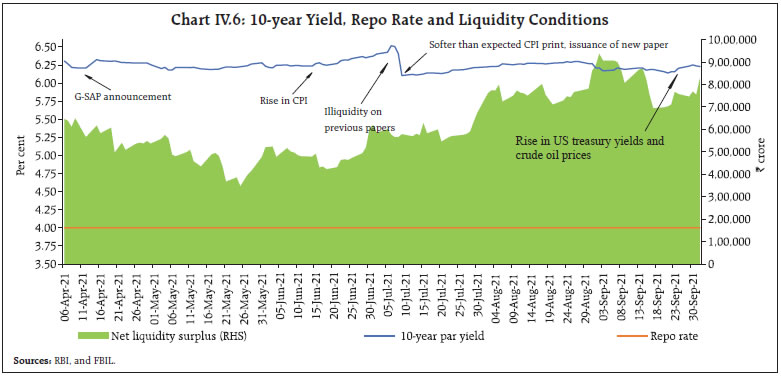 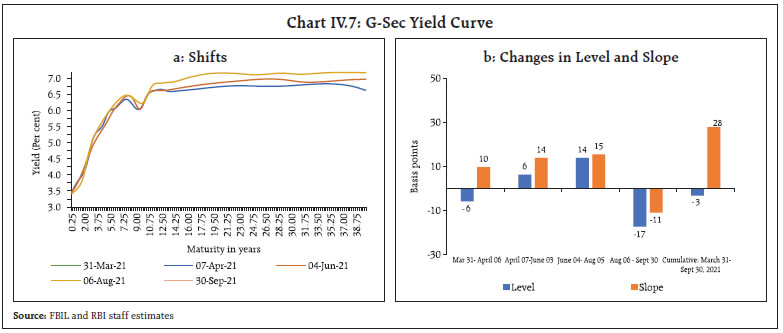 State Development Loans The weighted average spread of cut-off yields on state development loans (SDLs) over G-sec yields of comparable maturities declined to 48 bps in H1:2021-22 from 53 bps in H1:2020-21 (Chart IV.9). The average inter-state spread on securities of 10-year tenor (fresh issuances) was 4 bps in H1:2021-22 as compared with 9 bps in H1:2020-21. 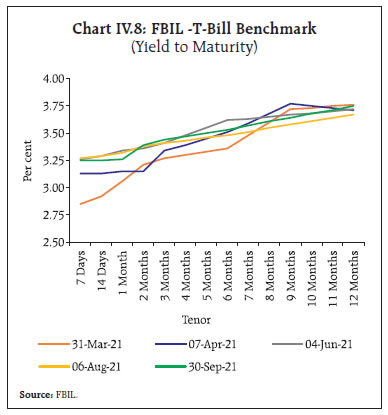 IV.1.3 Corporate Bond Market Corporate bond yields softened during H1:2021-22 while risk premia (over G-sec yields of comparable maturities) exhibited a mixed trend amidst moderation in new issuances. The monthly average yield on AAA-rated 3-year bonds issued by NBFCs declined by 37 bps to 5.32 per cent, while those on corporates and public-sector undertakings (PSUs), financial institutions (FIs) and banks moderated by 32 bps to 5.24 per cent and by 48 bps to 5.33 per cent, respectively (Chart IV.10a). During the same period, the monthly average risk premium or spread on AAA-rated 3-year bonds (over 3-year G-sec yields) increased marginally from 48 bps to 49 bps for NBFCs and from 35 bps to 40 bps for corporates while moderating from 60 bps to 50 bps for PSUs, FIs and banks (Chart IV.10b). 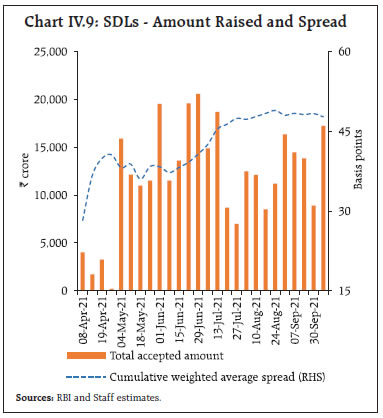 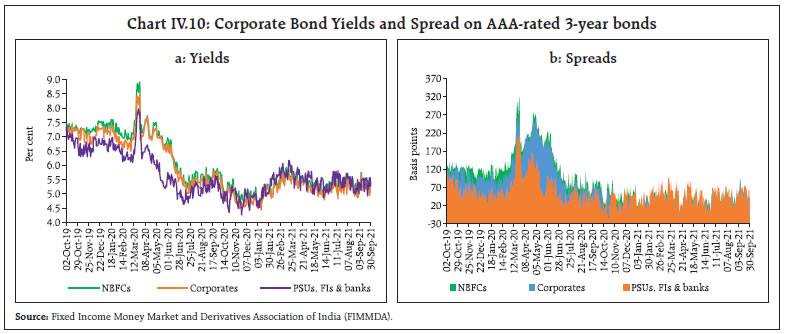 Corporate bond yields eased across tenors and ratings spectrum. For the lowest rated investment grade corporate bonds (BBB-), yields declined by 18 bps (Table IV.1). The market perception of credit risk also improved, with the 3-year credit default swap (CDS) spreads for the State Bank of India and the ICICI Bank moderating by 2 bps and 3 bps, respectively, during H1. Issuances of corporate bonds in the primary market declined to ₹1.81 lakh crore during H1:2021-22 (up to August 2021) from ₹3.17 lakh crore during the corresponding period of the previous year (Chart IV.11a). Resource mobilisation in the corporate bond market was overwhelmingly through the private placement route (97.0 per cent). Outstanding investments by foreign portfolio investors (FPIs) in corporate bonds declined marginally from ₹1.33 lakh crore at end-March 2021 to ₹1.28 lakh crore at end-September 2021. Consequently, their utilisation of the approved limits declined from 24.5 per cent to 22.3 per cent. The daily average secondary market trading volume declined by 26.0 per cent to ₹7,056 crore during H1 (up to August 2021) over the corresponding period of the previous year, in sync with the reduction in new issuances (Chart IV.11b). 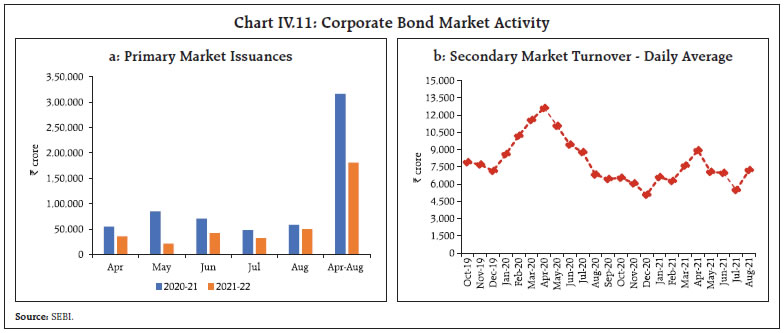 Most of the debt issuances in H1:2021-22 were undertaken by firms in financial services, banking/term lending, and the housing finance sector (Chart IV.12). IV.1.4 Equity Market The Indian equity market scaled new highs in H1:2021-22, lifted by the gradual normalisation of economic activity post the second wave, strong corporate earnings, and pick-up in the vaccination drive. The BSE Sensex gained 19.4 per cent in H1 to close at 59,126 on September 30, 2021 (Chart IV.13a). Indian equities emerged as the best performing amongst peers on a year to date (YTD) basis (Chart IV.13b) with their share in world market capitalisation increasing to 2.93 per cent on September 30, 2021 from the long-term average of 2.43 per cent (Chart IV.13c). During H1:2021-22, FPIs were net buyers to the tune of ₹ 8,326 crore while net purchases of domestic institutional investors (DIIs) amounted to ₹47,763 crore (Chart IV.13d).  The bull run rode on higher domestic participation, buoyed by the increasing interest of retail investors. Direct retail holdings in NSE listed stocks rose to 7.2 per cent of market capitalisation in June 2021 from 6.4 per cent in December 2019 (Chart IV.14a). The number of dematerialised (Demat) accounts with the country’s two main depositories has gone up from 5.5 crore at end-March 2021 to 6.49 crore at end-July 2021. Furthermore, indirect retail participation through monthly systematic investment plans (SIPs) reached a new high of ₹9,923 crore in August – 8.1 per cent above March 2021. The number of retail SIP accounts surged to 4.3 crore with 24.9 lakh new accounts registered in August – the highest-ever monthly registration (Chart IV.14b).  The exuberance in the equity market was also reflected in the IPO segment. During H1:2021-22, 22 IPOs were listed, mobilising ₹46,316 crore as against ₹1,798 crore in the corresponding period last year (Chart IV.15a). The amounts raised through rights issues, however, fell sharply to ₹793 crore in H1from ₹59,983 crore during the corresponding period of the previous year. The total mobilisation through public and rights issues reduced to ₹50,529 crore from ₹76,830 crore over the same period. 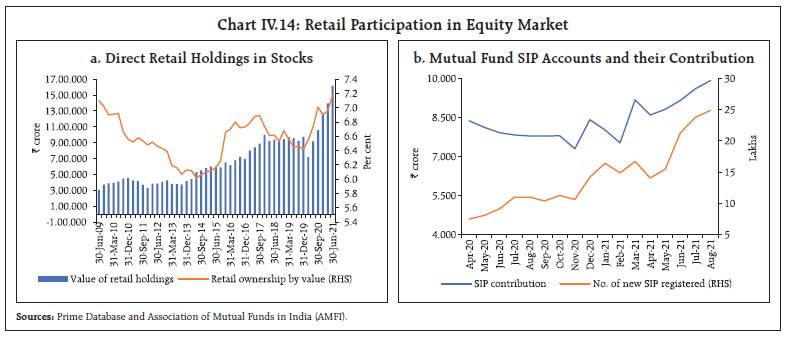 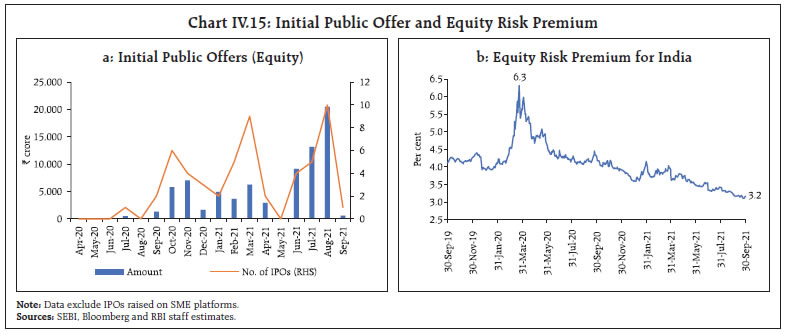 The equity risk premium (ERP)3 – the difference between returns on equity and the risk-free rate – eased through H1:2021-22 with the gradual recovery in market sentiments and moderated from 6.3 per cent at the height of the pandemic (end-March 2020) to 3.2 per cent by end-September 2021, moving below the pre-pandemic level (Chart IV.15b). IV.1.5. Foreign Exchange Market The Indian rupee (INR) exhibited two-way movements in H1:2021-22. It traded with a depreciating bias in April 2021 and touched ₹75.17 per US dollar on April 15 amidst FPI outflows and an appreciation of the US dollar (Chart IV.16). The depreciating bias quickly reversed as FPI flows rebounded with a sharp fall in domestic COVID-19 cases and a weakening US dollar. By May 28, the INR appreciated to ₹72.48. In June, it traded with a depreciation bias, despite robust FPI equity inflows, as the US dollar gained traction. Since then, the INR has moved in both directions driven by FPI flows, crude oil prices and incoming information on monetary policy normalisation plans of major advanced economies.  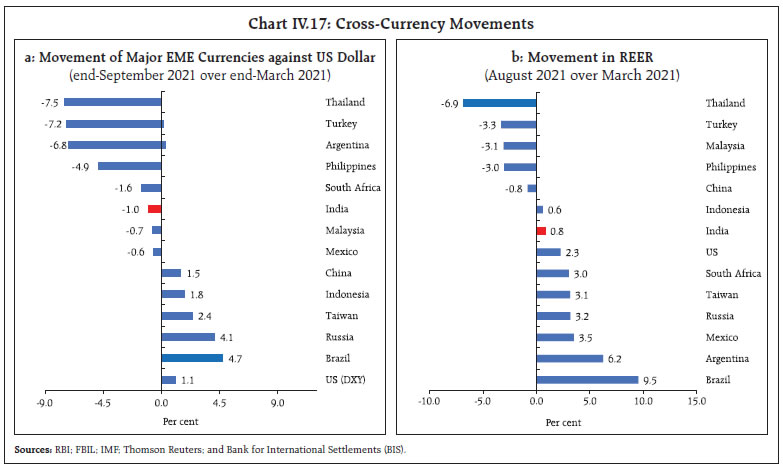 The depreciation of the INR in nominal terms (against the US dollar) as well as the appreciation of the real effective exchange rate (REER) in H1 was modest relative to EME peers (Chart IV.17). In terms of the 40-currency nominal effective exchange rate (NEER), the INR depreciated by 0.9 per cent (at end-September 2021 over the average of March 2021), while it appreciated by 1.3 per cent in terms of the 40-currency REER (Table IV.2). The divergence between the two indices essentially reflects India’s higher inflation vis-à-vis its major trading partners. IV.1.6 Credit Market During H1, credit offtake improved, with non-food credit growth (y-o-y) increasing to 6.8 per cent on September 24, 2021 from 5.1 per cent a year ago (Chart IV.18). Credit growth among public sector banks remained modest, while there has been some uptick in the case of the private sector banks (Chart IV.19a), which have provided the bulk (56.7 per cent) of the incremental credit extended by scheduled commercial banks (SCBs) on a y-o-y basis (as on September 24, 2021). 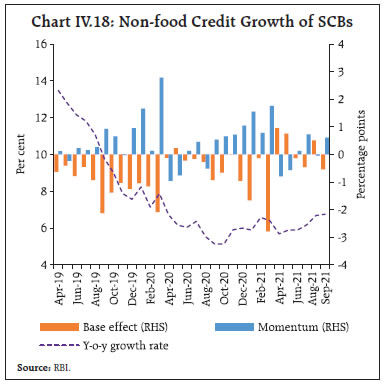 They were followed by public sector banks (33.3 per cent) and foreign banks (10.0 per cent) (Chart IV.19b). Among the major sectors4, credit to agriculture continued to register double-digit growth since April 2021 and accelerated to 11.3 per cent (y-o-y) in August 2021 on the back of a favourable monsoon and measures to support the farm sector (Chart IV.20a). Industrial credit growth remained subdued, mainly due to a decline in credit to large industries (which account for more than 80 per cent of credit extended to the sector). Credit to medium, and micro and small industries improved, benefitting from the government’s support measures for the MSME sector and the enhancement of the emergency credit line guarantee scheme (ECLGS) to support COVID-19 affected sectors. Services sector credit growth decelerated, dampened by the second wave of the pandemic. In terms of the contribution of different sectors in incremental credit (y-o-y basis), personal loans accounted for the largest share (52.5 per cent) followed by the agriculture sector (22.2 per cent) (Chart IV.20b). The overall non-food credit growth in H1:2021-22 remains primarily driven by personal loans and credit to the agriculture sector (Chart IV.20c). Within industry, credit to textiles, and chemicals and chemical products registered accelerated growth in H1:2021-22 (up to August). Credit to infrastructure – which accounts for around 38 per cent of industrial credit – also showed improvement, led by credit to roads and airports. Credit growth to food processing, beverage and tobacco lost momentum, while credit to basic metal and metal products contracted (Chart IV.21a). The prime drivers of overall credit growth to industry were infrastructure and textiles (Chart IV.21b). 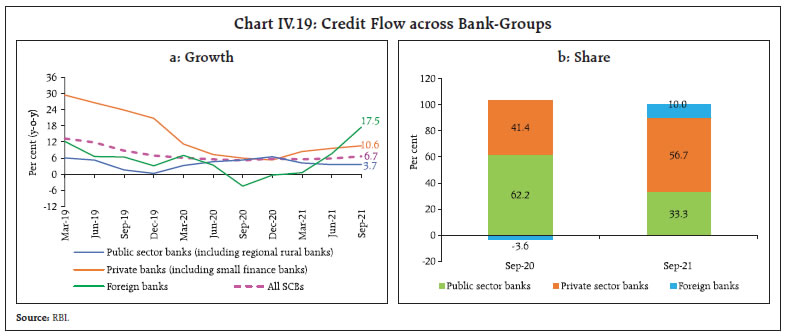 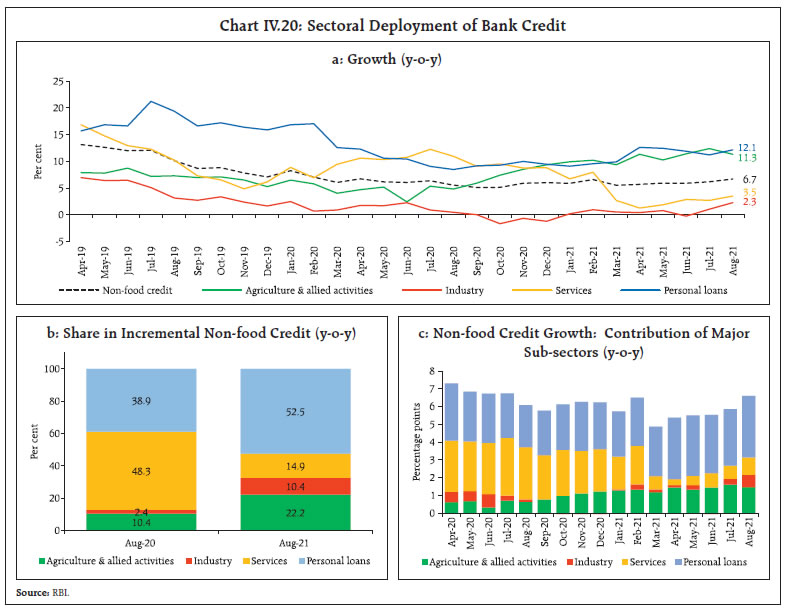 Credit growth to the services sector decelerated to 3.5 per cent in August 2021 from 10.9 per cent a year ago, largely due to slowdown in credit to NBFCs that have been raising resources mainly from money and debt markets. Credit growth to transport operators, however, recovered in August 2021 after slipping into negative territory in April 2021 (Chart IV.21c). Credit to the trade sector contributed 1.5 percentage points to the overall credit growth of the services sector in August 2021 (Chart IV.21d). Credit growth to personal loan segment accelerated to 12.1 per cent in August 2021 from 8.5 per cent a year ago, supported by special schemes of banks to support households during the pandemic. Credit to housing, the largest constituent of the personal loan segment, showed signs of recovery in H1: 2021-22 (up to August 2021).  The asset quality of SCBs improved during 2021-22 (up to June), with the overall non-performing assets (NPA) ratio declining to 7.5 per cent in June 2021 from 8.0 per cent a year ago (Chart IV.22a). The NPA ratio in respect of retail loans and services increased over the same period (Chart IV.22b). Banks’ non-SLR investments – covering instruments like CPs, bonds, debentures and shares of public and private corporates – were lower during H1:2021-22 than a year ago mainly due to lower investment in bonds/shares and debentures (Chart IV.23a). Adjusted non-food credit5 growth increased from 5.1 per cent in Q2:2020-21 to 6.2 per cent in Q2:2021-22 (Chart IV.23b). 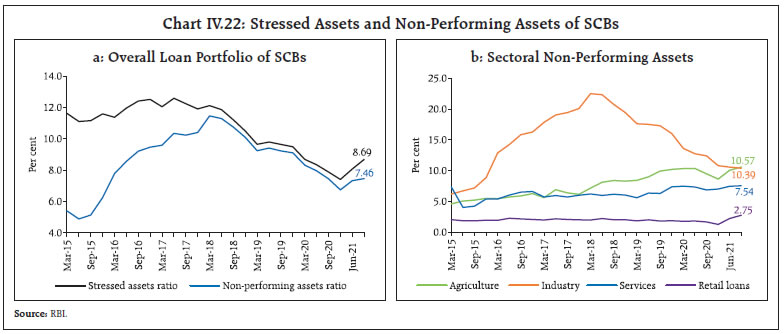 With credit offtake remaining muted relative to deposit growth, banks augmented their statutory liquidity ratio (SLR) portfolios. Excess SLR investments rose to 12.5 per cent of net demand and time liabilities (NDTL) on September 10, 2021 from 11.0 per cent of NDTL at end-March 2021. This provides banks the cushion to meet their liquidity coverage ratio (LCR) requirements and collateral buffers for availing the liquidity adjustment facility (LAF) of the RBI (Chart IV.24). IV.2 Monetary Policy Transmission Monetary transmission to deposit and lending rates of banks improved further in H1:2021-22. The abundance of systemic liquidity, forward guidance by the MPC of continuing with the accommodative stance, subdued credit demand and the introduction of the external benchmark regime for select sectors in October 2019 aided monetary transmission. There has been a complete pass-through of the policy repo rate cuts to the weighted average lending rate (WALR) on fresh rupee loans since October 2019 (Table IV.3). 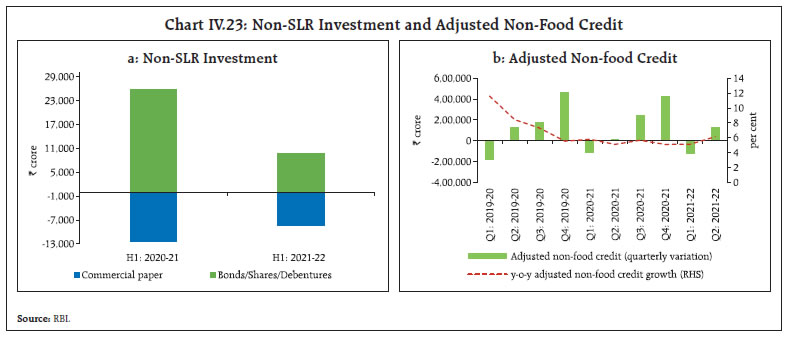 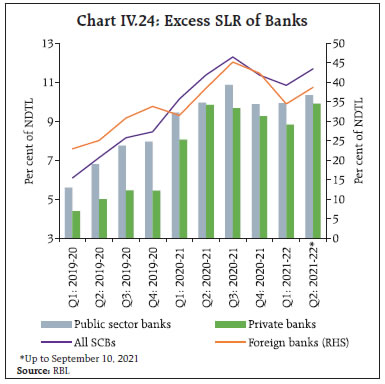 The transmission of policy repo rate cuts to the WALR on outstanding loans has also been sizeable at 120 bps in the external benchmark period (Box IV.1).
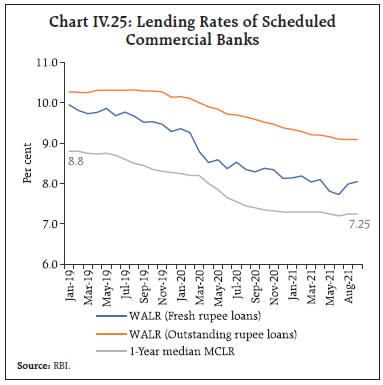 This has been facilitated by the sustained reduction in the marginal cost of funds-based lending rate (MCLR) – the one-year median MCLR fell from 8.8 per cent in January 2019 to 7.25 per cent in August 2021 (Chart IV.25)8. Across bank groups, foreign banks exhibited maximum transmission to lending and deposit rates, reflecting a higher proportion of their liabilities being made up of low cost and lower duration wholesale deposits, which facilitates a faster repricing of interest rates (Chart IV.26). Among domestic banks, public sector banks (PSBs) and private sector banks (PvBs) exhibited a similar degree of pass-through to lending rates. The WALRs of PSBs, however, remain lower than those of PvBs9. The decline in WALRs on fresh rupee loans as well as outstanding rupee loans has been broad-based across sectors. For fresh loans, the decline in WALR was the sharpest in the case of education loans, followed by other personal loans and loans to large industries (Chart IV.27). 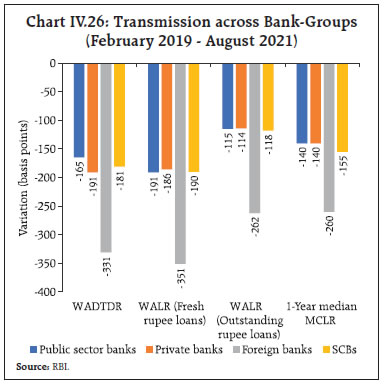 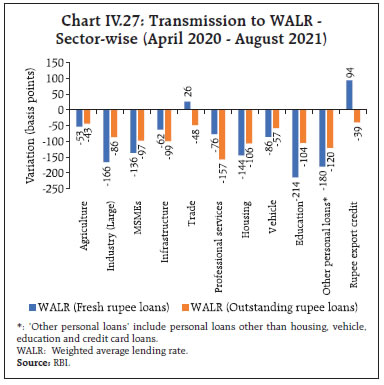 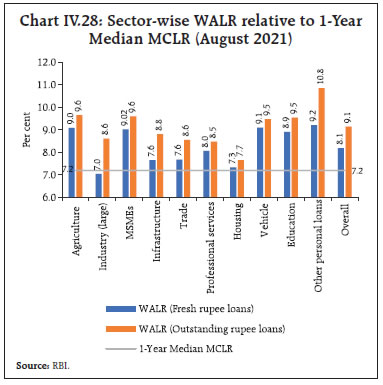 Spreads of WALRs on fresh rupee loans (relative to 1-year MCLR) are the lowest in the large industry segment. Among retail loans, the spread charged by domestic banks was the lowest in respect of housing loans, given the lower risk of default and the availability of collateral. Other personal loans, i.e., loans other than housing, vehicle and education are mostly unsecured and carry higher credit risk, mirrored in higher spreads (Chart IV.28). The WALRs in respect of fresh rupee loans in the retail segment and loans to MSMEs declined significantly during the period October 2019-August 2021 (Chart IV.29). In respect of fresh rupee loans linked to the policy repo rate, the spread – WALR (fresh rupee loans) over the repo rate – charged by domestic banks during August 2021 was the lowest in the case of housing loans and the highest in the case of other personal loans, in line with their risk profiles. The spreads charged by PSBs for vehicle and education loans were lower than those of private banks, while they were higher for MSME loans and other personal loans (Table IV.4). 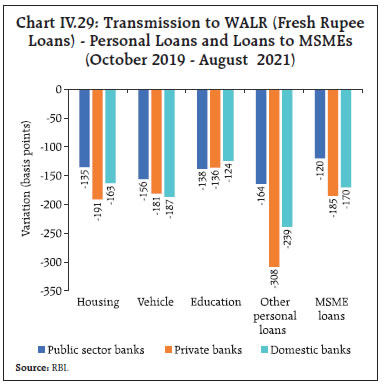 There has been a moderation in deposit rates across tenors (Chart IV.30a). The median term deposit rate on fresh deposits – based on average card rates on fresh deposits across all tenors – has declined by 154 bps since March 2020 with a perceptible moderation in shorter tenor deposits of up to one-year maturity (180 bps) (Chart IV.30b). Consequently, the weighted average domestic term deposit rate (WADTDR) on outstanding rupee deposits declined by 135 bps during the period March 2020 to August 2021. The median saving deposit rate for domestic banks, which had remained sticky at 3.5 per cent during October 2017 to May 2020, declined to 3 per cent in June 2020 and has remained at the same level since then. 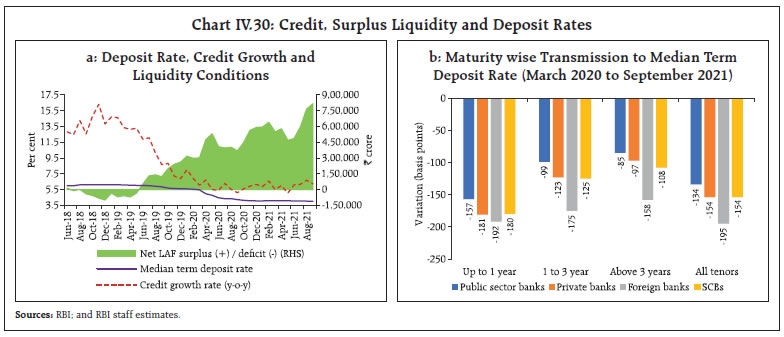 Amongst domestic banks, PvBs have exhibited higher pass-through to term deposit rates compared to PSBs, resulting in some convergence in the levels of their deposit rates (Chart IV.31). Interest rates on small saving schemes are administered by the Government of India and are fixed on a quarterly basis at a spread of 0-100 bps over and above G-sec yields of comparable maturities. The Government has left the interest rates on various small savings instruments unchanged since Q2:2020-21. The currently prevailing rates are 47-178 bps higher than the formula-based rates for Q3:2021-22 (Table IV.5). With the moderation in interest rates on bank deposits and unchanged interest rates on small savings, the latter have become attractive to depositors. The growth in accretions under small savings has consistently been above that of bank deposits since 2018 and the gap has widened, with implications for monetary transmission as and when credit demand picks up (Chart IV.32). 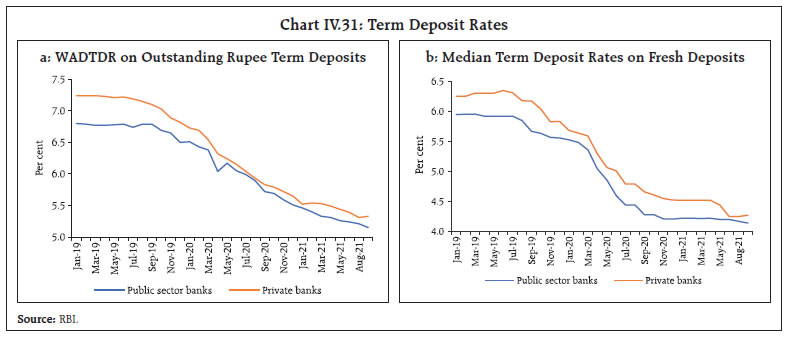 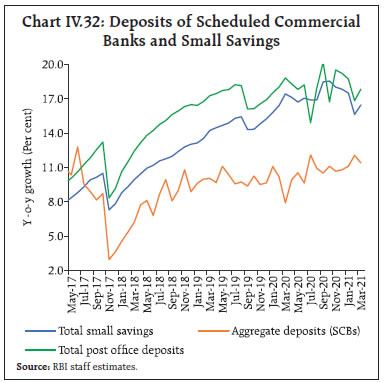 IV.3 Liquidity Conditions and the Operating Procedure of Monetary Policy The RBI Act, 1934 requires the Reserve Bank to place the operating procedure relating to the implementation of monetary policy and changes thereto from time to time, if any, in the public domain. In consonance with the MPC’s accommodative stance, the Reserve Bank continued with liquidity easing measures during H1:2021-22, aimed at nurturing and supporting the nascent growth impulses. The RBI announced a secondary market G-sec acquisition programme or G-SAP 1.0 in April 2021, with a commitment to a specific amount of open market purchases of government securities. The G-SAP is unconventional on several counts. First, the RBI commits upfront the amount to be purchased in contrast to regular OMO purchases which are discretionary. Second, it entails continued support to the market in view of the large government borrowing programme. Third, the size of the purchases is significantly larger than OMOs in normal times, thus boosting demand for G-secs amidst elevated supply during 2021-22. During Q1, the RBI conducted three auctions under G-SAP 1.0 and purchased G-secs (including SDLs) of ₹1.0 lakh crore, in line with the announced amount. In Q2, six auctions were conducted under G-SAP 2.0 aggregating ₹1.2 lakh crore. The G-SAP 2.0 auctions conducted on September 23 and September 30, 2021 for ₹15,000 crore each were accompanied by simultaneous sales of G-secs of identical amount. Overall, net liquidity injected through OMO purchases, including G-SAP, amounted to ₹2.4 lakh crore in HI. Under the G-SAP, the RBI purchased both on the run (liquid) and off the run (illiquid) securities across the maturity spectrum, with more than 68 per cent of the purchases concentrated in over 5 to 10-year maturity segment, thus imparting liquidity to securities across the term structure (Table IV.6). By containing volatility in G-sec yields – the benchmarks for the pricing of other financial market instruments – G-SAP helped to keep interest rates benign, thereby facilitating monetary transmission. Drivers and Management of Liquidity During Q1:2021-22, currency expansion, build-up of GoI cash balances and the restoration of the cash reserve ratio (CRR) to its pre-pandemic level were the main sources of liquidity leakage while its accretion was through G-SAP and forex purchases (Table IV.7). Surplus liquidity – as reflected in average daily net absorptions under the LAF – amounted to ₹5.1 lakh crore. Lower liquidity leakage due to subdued currency expansion added to the persistence of large surplus liquidity in H1:2021-22 (Chart IV.33). Despite the second wave of the pandemic being more virulent, the precautionary demand for cash remained muted. In Q2, the usual return of currency during the monsoon season, renewed vigour of capital inflows along with liquidity injections through G-SAP 2.0 augmented surplus liquidity. As a result, average daily net liquidity absorptions in Q2 soared to ₹7.3 lakh crore. Unabated capital inflows reflected on the forward premium curve in the forex market – its shape being determined by the interplay of institutional features and regulatory aspects with the market microstructure and flow factors, apart from macroeconomic fundamentals (Box IV.2). 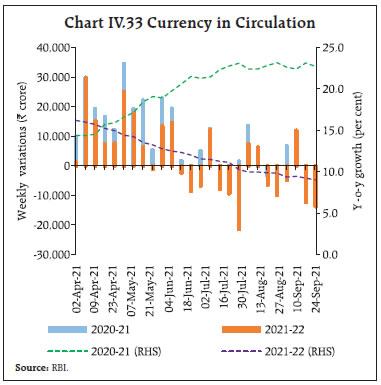
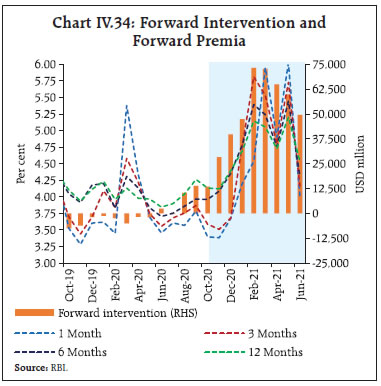 With the moderation of the forward book in H1:2021-22 (up to July), the pressure on the forward premia somewhat eased (Chart IV.34). The gradual normalisation of liquidity management operations in sync with the revised liquidity management framework instituted in February 2020 was a key feature of liquidity management during H1:2021-22. As a part of this process, the CRR was restored to its pre-pandemic level of 4.0 per cent of NDTL in two phases of 0.5 percentage point increase in the fortnights beginning March 27, 2021 and May 22, 2021. The surplus liquidity was mopped up through the overnight fixed rate reverse repo and the VRRR auctions of varying maturities under the LAF. Keeping in view the markets’ feedback and appetite for higher remuneration, the Reserve Bank enhanced the size of the fortnightly VRRR auctions in a phased manner from ₹2.0 lakh crore during April-July to ₹2.5 lakh crore on August 13, 2021; ₹3.0 lakh crore on August 27, 2021; ₹3.5 lakh crore on September 9, 2021; and ₹4.0 lakh crore on September 24, 2021. These were supported by fine-tuning operations conducted through VRRRs of 3, 4 and 7 days maturities. Notwithstanding the phased increase in the size of VRRRs, the surplus liquidity absorbed through fixed rate reverse repo remained around ₹4.7 lakh crore (on an average) in H1 (Chart IV.35). 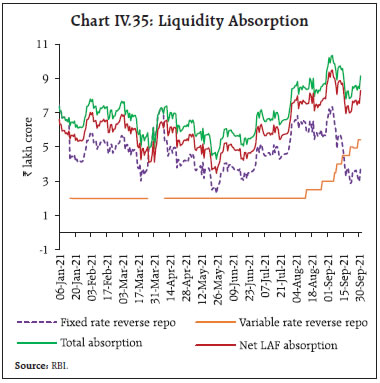 The enhancement in VRRR size was initially interpreted as a precursor to reversal of liquidity measures leading to a transient spike in G-sec yield on the policy day, i.e., August 7, 2021 (Chart IV.36a). Such fears, however, were unfounded as evident from the relative stability in the bid-cover ratios of 14-day VRRR auctions in the immediate fortnights after the policy announcement vis-à-vis before (Chart IV.36b). Reflecting the liquidity injections through G-SAP and capital inflows, reserve money (RM) increased by 14.7 per cent (y-o-y) as on September 24, 2021 (9.1 per cent adjusted for the first-round impact of the change in the CRR) while money supply (M3) increased by 9.3 per cent (y-o-y) as on September 24 (Table IV.8). 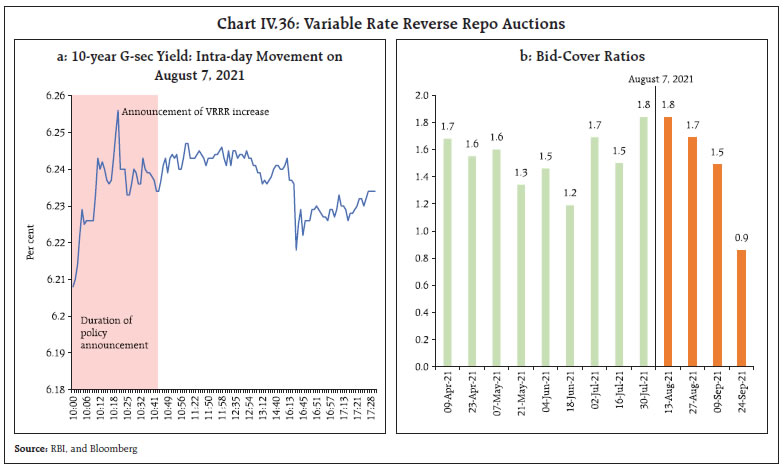 Other Liquidity Measures Apart from G-SAP, the RBI continued with measures to meet targeted sectoral credit needs to nurture the nascent economic recovery in H1. These measures included (i) special refinance facilities of ₹66,000 crore to all-India financial institutions (AIFIs) comprising ₹25,000 crore to the National Bank for Agriculture and Rural Development (NABARD); ₹10,000 crore to the National Housing Bank (NHB); and ₹31,000 crore to the Small Industries Development Bank of India (SIDBI) to support and nurture the recovery; (ii) term liquidity facility of ₹50,000 crore to ramp up COVID-related healthcare infrastructure and services in the country; (iii) special long-term repo operations (SLTRO) for small finance banks (SFBs) of ₹10,000 crore to be deployed for fresh lending of up to ₹10 lakh per borrower; (iv) on-tap liquidity window of ₹15,000 crore in order to mitigate the adverse impact of the second wave of the pandemic on certain contact-intensive sectors13. Overall, the Reserve Bank has announced liquidity enhancing measures worth ₹17.2 lakh crore (8.7 per cent of nominal GDP of 2020-21) since February 6, 2020 (Table IV.9). Domestic financial markets broadly remained stable and in sync with the accommodative policy stance of the MPC and the Reserve Bank’s continued calibrated liquidity injection measures. Market activity was vibrant, with short-term rates easing appreciably along with thinning of spreads. The renewed vigour of capital inflows and the infusion of discretionary liquidity through G-SAP resulted in a substantial increase in surplus systemic liquidity, which was modulated through increases in VRRR amounts and fine-tuning operations. Monetary transmission improved further amidst nascent signs of an upturn in credit growth. Going forward, liquidity conditions are expected to continue to be accommodative in consonance with the monetary policy stance, through calibrated liquidity management operations. Imparting momentum to the nascent economic recovery process and putting it on a sustained and durable basis through efficient policy transmission would continue to assume primacy in the hierarchy of policy objectives. __________________________________________________________________________________ 1 ‘Traded deals’ are negotiated directly on the NDS-Call platform whereas ‘reported deals’ are over-the-counter (OTC) deals which are reported on the NDS-Call platform after the completion of negotiation of deals. 2 The level is the average of par yields of all tenors up to 30-years published by FBIL and the slope (term spread) is the difference in par yields of 3-months and 30-year maturities. 3 Sachdeva, P. and A. Borad (2020), “Demystifying Equity Prices using Dividend Discount Model: An Indian Context”, Reserve Bank of India Bulletin, October. 4 Data on sectoral credit relate to select banks accounting for around 90 per cent of the total non-food credit. 5 Sum of non-food credit extended by SCBs and their investments in commercial paper, bonds/shares/debentures issued by private and public corporate sector. 6 Unit root tests indicate that WALR_f, REPO and CD Ratio are I(1). Based on AIC criteria, ARDL(3,1,1) model is selected. Bounds test confirms cointegration at 1 per cent level of significance. 7 In equation 2, DumEBLR is dummy for the external benchmark period, i.e., October 2019 to June 2021; DumTAPR is dummy for taper tantrum period (July to September 2013); and DumDEMO is dummy for the demonetisation period (November 2016 to February 2017). 8 With the policy rate cut cycle commencing in February 2019, more and more loans linked to MCLR (primarily in the 1-year bucket) are getting reset from February 2020. 9 The WALR on fresh rupee loans for public sector banks and private sector banks stood at 7.51 per cent and 8.83 per cent, respectively, in August 2021. 10 The level is the weighted sum of changes in forward premia rates with the same sign across all maturities; a level shock changes the rates by identical amounts across all maturities, indicating a parallel shift of the forward premia curve. The slope weighs changes in rates for short maturities with a negative sign and those of medium and long maturities with a positive sign. Finally, the curvature associates positive signs with short and long-term changes but negative signs with medium-term rate changes; a disproportionate shock to the medium-term rates vis-a-vis the short and long term rates impacts the hump of the curve (Litterman and Scheinkman, 1991). 11 A random forest is a supervised machine learning algorithm that assesses the relative importance of each variable on the prediction. 12 Apart from lagged variables as instruments, implied volatility of INR per USD rates for 3-months is used as an instrument variable for forward intervention; the residuals from regressing stock market volatility on policy uncertainty are used as an instrument for the stock market variable. 13 As an incentive, banks were permitted to park their surplus liquidity up to the size of the loan book created under this scheme with the Reserve Bank under the reverse repo window at a rate which is 25 bps lower than the repo rate i.e., 40 bps higher than the reverse repo rate. The global economic activity gained traction in Q2:2021 (April-June). In Q3, however, the momentum of the global recovery seems to have weakened across the board as the rapid spread of more virulent strains of the virus weighed on business conditions. Elevated commodity prices and overstretched supply chains are keeping input price pressures high, posing upside risks to headline inflation. The divergence in monetary policy actions and stances is amplifying the unequal and uneven nature of the global recovery and increasing the downside risks to the outlook, while global financial markets are turning volatile. In the aftermath of the April 2021 MPR, daily new infections appeared to have peaked in major advanced economies (AEs) and a few emerging market economies (EMEs), allowing easing of restrictions and global economic activity to gain traction in Q2:2021 at a diverging and unequal pace on the basis of scale and speed of vaccination. Starting June, however, the momentum of the global recovery seems to have weakened across the board as the rapid spread of more virulent strains of the virus weighed on business conditions in most major economies, pulling down global purchasing managers’ index (PMI) readings and is likely to reflect in lower GDP growth in Q3. Besides, still rising commodity prices and overstretched supply chains are keeping input price pressures high, posing upside risks to headline inflation. Several EME central banks and a few in the AEs have responded with policy rate hikes and unwinding of policy stimulus. The divergence in monetary policy actions and stances is amplifying the unequal and uneven nature of the global recovery and increasing the downside risks to the outlook. Global financial markets remained buoyant up to early-September before increasingly turning volatile. Even as stock markets in a few countries scaled fresh peaks in September 2021, most saw sharp correction. In the bond markets, yields remained range-bound up to August in most AEs but rose sharply in September. In EMEs, bond yields moved bi-directionally but rose in the latter part of September, in sync with the AEs. The US dollar has strengthened in anticipation of taper and higher inflation outcomes in the US. V.1 Global Economic Conditions Economic activity accelerated in major AEs and EMEs in Q2:2021, but faltered in Q3, with most economies yet to return to their pre-pandemic levels. In the US, the economic rebound that commenced in H2:2020 continued into H1:2021, with GDP bouncing back to its pre-pandemic level in Q2:2021 (Table V.1). Sustained policy support, easing of restrictions and vaccination supported a strong pick-up in consumer spending. Non-farm payroll showed signs of steady improvement during May-July indicating the mending of labour market conditions; however, it softened in August to a seven-month low amidst rising infections. Employment remains below the pre-pandemic level and the Federal Reserve (Fed)’s goal of maximum employment, beset with hiring difficulties and labour supply shortages. Incoming data for Q3 also suggest that the momentum of growth may have moderated – consumer sentiment plummeted in August to its lowest level in nearly a decade due to surging delta variant infections and inflation concerns, before rising marginally in September. The manufacturing PMI eased in July due to persistent supply side frictions but improved in the next two months even as the rising infections caseload weighed on the outlook. After slipping into a double dip recession in Q1:2021, the Euro area rebounded sharply in Q2, growing at 9.2 per cent [q-o-q, seasonally adjusted annualised rate (SAAR)], as most major constituent economies returned to growth following gradual withdrawal of restrictions. Significant progress on vaccination, together with falling rates of incidence, boosted consumer and business sentiments, and brightened the prospects for domestic demand and employment. In Q3, however, the economy seems to have lost some steam, as evident from high frequency indicators. The composite PMI, though in strong expansion, moderated in August and September from its 15-year high in July, as capacity constraints dragged on the manufacturing PMI, while services PMI fell to a four-month low in September. The Japanese economy picked up in Q2 at a pace higher than expected, but much weaker than other major AE peers. Resilient external demand underpinned a recovery in exports and capital expenditure. In Q3, however, the country is less likely to maintain this momentum as the upsurge in cases of more virulent strains pushed the economy into its fourth state of emergency in early July which was extended till September. The fallout from the renewed wave is already getting reflected in incoming data as industrial growth turned weaker in July and August and the manufacturing PMI, though in expansion zone, moderated in Q3. The composite PMI remained in contraction zone up to September, reflecting a sharp deterioration in business activity in the services sector. In the UK, GDP grew sharply in Q2:2021 – as against a contraction in Q1 – as the gradual rollback of COVID-related restrictions together with rapid vaccine rollouts aided a strong rebound in household consumption and public spending. With increasing caseload intensifying the risk of another round of lockdown restrictions, the pace of recovery slowed in Q3. The composite PMI eased for the fourth consecutive month in September as output growth in both manufacturing and services weakened amidst stringent supply constraints. The Chinese economy expanded by 7.9 per cent (y-o-y) in Q2. Successful containment of several sporadic virus outbreaks together with sustained policy measures kept exports and manufacturing activity well supported, thus powering a steady recovery. Domestic consumption, however, remains a weak spot and the economy exhibited signs of slowing down in Q3. Both manufacturing and services PMI slipped back into contraction in August for the first time since April 2020 following the deterioration in business conditions. In September, manufacturing PMI had the neutral reading of 50, i.e., neither expansion nor contraction. The deterioration in real estate, rising input costs, regulatory crackdown on corporates in recent months and growing power outages are the major headwinds. An examination of key macroeconomic indicators of BRICS economies reveals that the macroeconomic performance of India is likely to remain resilient in 2021 when compared with most other counterparts (Table V.2). The Brazilian economy contracted marginally on q-o-q basis in Q2:2021, reversing three successive quarters of sequential expansion since Q3:2020. Contraction in both industry and agricultural sectors on account of the resurgence of COVID-19 infections, weighed on economic activity. On the demand side, a sharp decline in gross fixed capital investment, together with muted household consumption, led to the downturn. In Q3, indicators are pointing to mobility gains, with paced up vaccination having boosted sentiments. Manufacturing PMI moderated in August but picked up in September, with production rising for the fifth successive month owing to a robust expansion in sales. The Russian economy remained resilient with GDP having reached its pre-pandemic level in Q2:2021. A sustained recovery in consumer spending and investment demand supported the uptrend, while elevated commodity prices and the gradual recovery of oil output lent further support. Some slowing of momentum is evident in Q3 as a third wave of infections since end-June impacted both domestic and foreign demand conditions leading to a decline in production and slowdown in new order growth. The manufacturing PMI is back into the contraction zone since June, while the composite PMI recorded its first contraction since December 2020 in August but was back in expansion zone in September. The South African economy has exhibited gradual recovery with four consecutive quarters of q-o-q expansion up to Q2:2021. The recovery was underpinned by strong growth in transport and communication, personal services and the agricultural sector, while household spending and exports lent support. In Q3, however, the pace of growth is likely to have decelerated as social unrest, mounting infections, slow vaccine rollouts and power outages weakened business conditions as also domestic demand. Among the South-East Asian economies, recovery remains slow-paced with renewed waves of contagious strains of COVID-19 amidst lagged inoculation rates. Stringent containment measures have resulted in deterioration of business conditions, pushing manufacturing PMI for all major ASEAN economies into contraction territory in August, for the first time since May 2020. The PMI manufacturing for the ASEAN region was at the neutral level of 50 in September. The OECD composite leading indicators (CLIs) available up to August 2021 suggest moderate improvement just above trend level across most major AEs, while for major EMEs it reflects diverging developments (Chart V.1a). The global composite PMI has moderated within the expansion zone, hitting a 7-month low in August, before rising marginally in September with PMI manufacturing remaining flat (Chart V.1b). Global trade showed signs of revival during Q4:2020 and recovered swiftly during H1:2021 across AEs and EMEs (Chart V.2a). Following the recent resurgence in global trade, the WTO has revised its growth forecast of merchandise trade volume to 10.8 per cent for 2021. However, persisting worldwide shortages in semiconductors and port congestion may moderate global trade recovery in certain sectors (Box V.1). The Baltic Dry Index, which measures shipping costs for a wide variety of bulk commodities such as coal, iron ore and grain, rose to a new high by end-September (Chart V.2b). 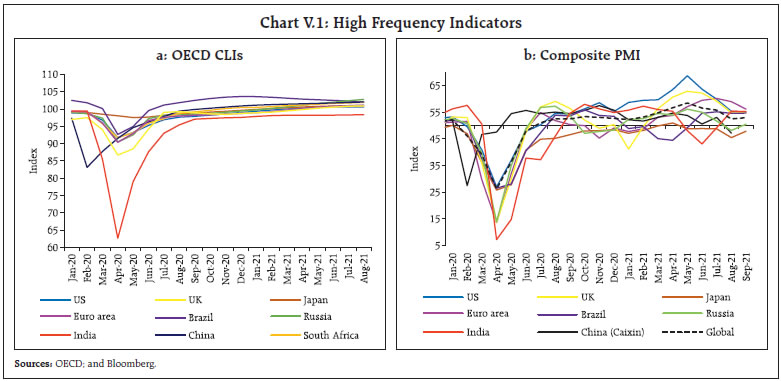
V.2 Commodity Prices and Inflation Global commodity prices have soared in 2021 so far, with intermittent corrections – the Bloomberg commodity price index increased by 20.7 per cent during April-September 2021. The food price index of the Food and Agriculture Organization (FAO) increased by 7.0 per cent between March and August 2021 (Chart V.3a). Prices of vegetable oil, cereal and dairy sub-indices have eased more recently because of seasonal production gains and softening import demand. In contrast, sugar and meat prices have continued to increase due to tightening supplies from major exporters amidst rising import demand. Crude oil prices rallied unevenly since April on improved demand prospects. Brent crude crossed US$70 per barrel in June, reaching its then highest level of 2021 in early July. From the second week of July, however, crude oil prices turned volatile – downward bias was imparted by rapid spread of the contagious delta variant, OPEC plus agreement to ease supply with an additional output of 400,000 barrels per day each month from August and rising stockpiles in the US. Price have firmed up since the latter part of August on tightening US supplies owing to slow recovery from disruption caused by Hurricane Ida and lower stockpiles in China. Brent crude prices ruled at nearly three-year highs at end-September, surging by 54.0 per cent on year-to-date basis. 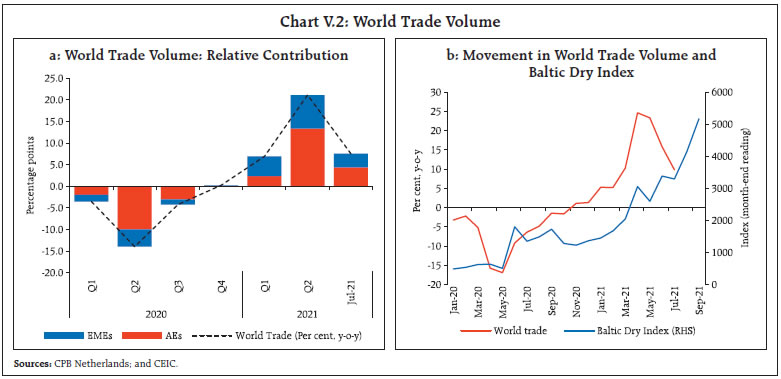 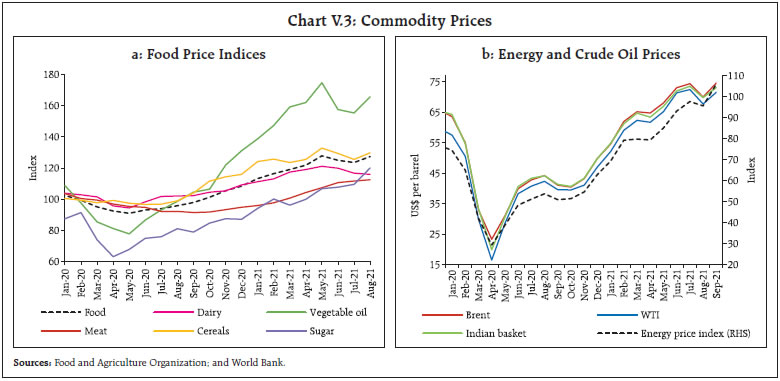 Base metal prices measured by the Bloomberg’s base metal spot index increased by 11.4 per cent during April-September 2021. The strong rally in prices witnessed in Q1:2021 continued into the first half of Q2 (Chart V.4). Most industrial metals, including copper and iron peaked in mid-May. The steady recovery in manufacturing activity across most major economies, along with rising supply bottlenecks, underpinned the metals bull run of H1:2021, sparking a debate on potential emergence of a fresh commodity super-cycle (Box V.2). Thereafter, prices for most metals have turned volatile in Q3, with iron giving up all early gains following China’s pro-climate measures. Gold prices rose in April and May on strong safe haven demand, but lost sheen in June on account of a strong US dollar. After remaining range-bound around the psychological level of US$1,800 per troy ounce during July to early September, prices plummeted in September with sharp rise in the US treasury yields and the US dollar. 
Prices firmed up across major AEs, pushing inflation above targets for most of them, barring Japan (Table V.3). For major EMEs, barring Indonesia and Thailand, headline inflation has remained close to the upper bound of the official target band or beyond, while for China, inflationary pressures have remained subdued in terms of consumer prices, notwithstanding strong upside pressures from producer prices. The return of inflation in the US has been stark. CPI inflation hit a 13-year high, reaching levels not seen since the global financial crisis. Fed’s preferred measure of inflation, the personal consumer expenditures (PCE) inflation, lagged CPI inflation but was at 30-year high level during July-August due to high energy and food prices. The surge in pent-up demand following the re-opening of economy, persistent supply-side constraints and high input costs are lending upside to inflation. The Fed attributes the spike in inflation to transitory factors. In the Euro area, the inflation rate moved beyond the European Central Bank (ECB)’s target of 2 per cent, surging to a 13-year high of 3.4 per cent in September on rising energy costs and prices of non-energy industrial goods and services, besides unfavourable base effect. The ECB too, attributes the recent rise in inflation to transitory factors and expects it to moderate back to the target once pandemic-induced shocks wane. CPI inflation in the UK edged up above the target in May-June and eased back to the 2 per cent target in July. In August, however, the inflation rate soared to 3.2 per cent, the highest ever jump in rate, mainly due to an unfavourable base effect. In Japan, unlike its AE counterparts, CPI remained in deflation for the eleventh consecutive month in August as COVID-19 continued to impact demand, keeping core inflation subdued, while a sharp drop in monthly mobile phone charges added to the downside (Chart V.5a). Among major EMEs, CPI inflation in Brazil has been above the upper bound of the tolerance band around the inflation target since February 2021. In August, CPI inflation rose to its highest reading since February 2016, primarily led by a surge in electricity and fuel prices amidst supply disruptions brought in by the worst drought witnessed by the country in almost a century. High global commodity prices, the depreciating Brazilian real and reviving demand are imparting upward pressure on prices. In Russia, inflation has been above the official target level since November 2020, scaling to a five-year high in August as rising inflation expectations, recovery in demand and strained supply capacity have kept inflationary pressures elevated. In South Africa, CPI inflation picked up from April due to increase in fuel costs, and high food and beverage prices. In June-July, however, inflation eased due to softening transport prices and favourable base effect before rising again in August on high fuel and food prices. China, on the other hand, remains an outlier with CPI inflation remaining highly subdued, primarily due to decline in food prices as also easing costs of transportation and communication amidst weak services sector demand (Chart V.5b). China’s producer price index, however, has risen sharply, pushing factory-gate inflation to its highest level in 13 years in August as high raw material costs and persistent disruptions due to global supply shortages exert upward pressure. 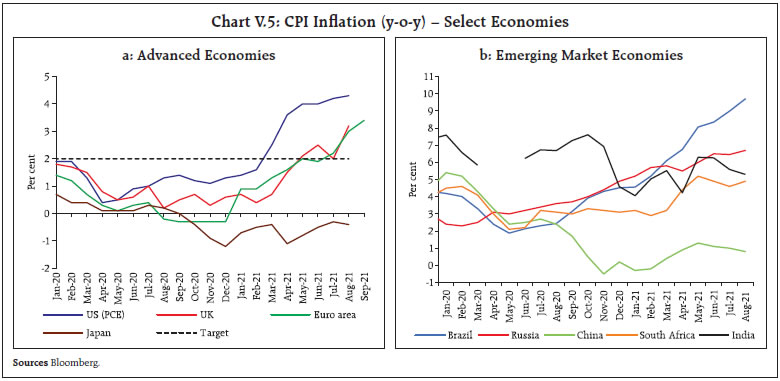 Extraordinary policy measures by monetary and fiscal authorities continue to support economies and ease financial conditions, helping to contain financial stability risks. The IMF estimates that since March 2020, US$16.5 trillion or about 15.9 per cent of global GDP had been pledged as fiscal support in response to the pandemic, with higher support extended by AEs vis-à-vis the EMEs (Table V.4). While most of the fiscal measures in the EMEs had expired in 2020, almost US$4.6 trillion worth of measures remain available to AEs as of early July 2021. The total monetary support extended globally by central banks is estimated to be about US$18.0trillion as of August 20214. This support has been predominantly in the form of asset purchases, around US$11.6 trillion, followed by lending operations of US$4.4 trillion. Monetary policy stances have diverged across countries, with a few major AEs and EMEs continuing to maintain an accommodative stance while others have begun/continued with the withdrawal of monetary stimulus. The US Fed maintained the target range for the federal funds rate at 0 to 0.25 per cent and the monthly pace of asset purchases at US$120 billion in all its meetings held in Q2 and Q3. In June, the Fed effected a hike of 5 basis points (bps) in the interest rate paid on required and excess reserve balances to 0.15 per cent. The interest rate on overnight reverse repurchase agreement (ON RRP) operations was also increased by 5 bps to 0.05 per cent. Effective July 29, the Fed merged the interest rates on excess reserves and required reserves to a single interest rate on reserve balances. The Fed also announced two standing lending facilities, both overnight and collateralised, viz., domestic standing repurchase agreement facility and a repo facility for foreign and international monetary authorities. The latter – initially a temporary facility introduced in end-March 2020 and extended up to September 2021 – is now a permanent facility. The September Federal Open Market Committee (FOMC) statement noted that if the progress towards its maximum employment and inflation goals continued as expected, a moderation in the pace of asset purchases would be warranted soon. The FOMC also doubled the per-counterparty limit for ON RRP operations to US$160 billion per day, effective September 23, 2021. The ECB maintained a hold on its policy rate and the quantum of asset purchases in its meetings in April and June. On July 8, the ECB unveiled its new monetary policy strategy under which a symmetric 2 per cent inflation target was adopted, as against the earlier target of below but close to 2 per cent. The Harmonised Index of Consumer Prices (HICP)remains the measure of the price level5 and the primary monetary policy instrument is the set of ECB policy rates. With the policy rates ruling close to their effective lower bound, the ECB would likely resort to other instruments such as forward guidance, asset purchases, longer-term refinancing operations and other new policy instruments as required. As part of the strategy review, the ECB also announced a detailed roadmap up to 2024 for its comprehensive action plan on climate change. In its July meeting, the first under the new framework, the ECB maintained an accommodative monetary policy stance to meet its inflation target and provided forward guidance that interest rates would remain at their current level or lower till the inflation target was durably achieved. In its September meeting, the ECB announced a moderately lower pace of asset purchases under the Pandemic Emergency Purchase Programme (PEPP), without reducing the overall quantum of the purchase programme that is scheduled to end by March 2022. It has kept purchases under the Asset Purchase Programme (APP) unchanged. The Bank of England (BoE) maintained a pause on the bank rate at its all-time low of 0.1 per cent and kept the total quantum of asset purchases unchanged in its meetings in May, June, August and September. In its August meeting, the BoE indicated that a modest tightening of monetary policy over its three-year forecast period is likely and it signalled that, given appropriate economic circumstances, it would begin unwinding its quantitative easing by not re-investing maturing assets once the bank rate is raised to 0.5 percent6. The Bank of Japan (BoJ) in its meetings in April, June, July and September kept the monetary policy parameters – the key policy rates and the quantum of asset purchases – unchanged. In July, the BoJ sketched the preliminary outline of the Fund-Provisioning Measure to Support Efforts on Climate Change. The new measure would come into effect in 2021 under which the BoJ would provide interest-free loans against collateral for up to one year, with possibility of rollover, for on-lending to projects that addressclimate change7. Moreover, banks would be allowed to add twice the amount of any borrowing under the scheme to their macro add-on balances, which would earn 0 per cent interest as against the policy rate, which is currently (-) 0.1 per cent. The Bank of Canada (BoC) maintained its policy rate and the forward guidance in its meetings in April, June, July and September but effected tapersof CAD$1 billion (approximately US$0.8 billion)8 in its weekly purchases of government bonds in the April and July meetings, reducing the weekly pace of asset purchases to CAD$2 billion (approximately US$1.6 billion). Central banks of four AEs, viz., Iceland, Czech Republic, South Korea and Norway have raised their policy rates in 2021 so far. The central bank of Iceland has effected two hikes of 25 bps each and the Czech National Bank has raised rates thrice to a cumulative increase of 125 bps. Bank of Korea and Norges Bank raised policy rates by 25 bps in August and September, respectively (Chart V.6a). Within the EMEs, there has mostly been status quo or a move towards unwinding monetary accommodation, though some countries have extended the stimulus also. For instance, the People’s Bank of China (PBoC) increased the liquidity in the system by lowering the reserve requirement for most financial institutions by 50 bps effective July 15, freeing up about 1 trillion yuan (approximately US$154.3 billion) of liquidity to support the real economy. The PBoC has, however, maintained the one-year Loan Prime Rate (LPR) at 3.85 per cent since April 2020. Amongst other BRICS central banks, Banco Central do Brasil followed up on its 75 bps rate action of March with equal hikes of 75 bps each in May and June and 100 bps each in August and September. The Bank of Russia followed up on its 25 bps rate hike of March with hikes of 50 bps each in April and June, 100 bps in July and 25 bps in September. The South African Reserve Bank maintained a pause in its May, July and September meetings. The central bank of Turkey, which had maintained status quo since a hike of 200 bps in March 2021, cut rates by 100 bps in September attributing high inflation to transitory factors and noting that monetary tightening had lowered credit and domestic demand. Amongst other EME central banks, Banco de México hiked rates by 25 bps each in June, August and September, while the Central Bank of Chile raised rates by 25 bps in July and 75 bps in August (Chart V.6b). The central banks of Peru and Hungary have also raised rates in recent months. 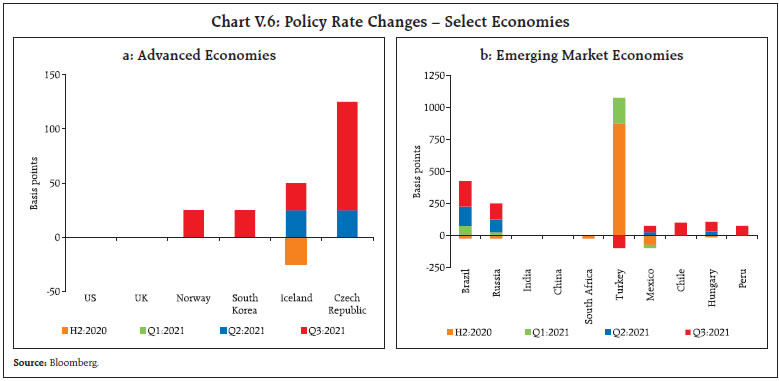 Global financial markets remained buoyant and easy financing conditions prevailed; however, volatility returned to the markets in September. Stock markets in a few AEs and EMEs scaled fresh peaks in September but slid in most countries. Bond yields, which had remained low up to August, edged up in September due to large sell-offs. The US dollar rallied in the wake of higher inflation and inflation expectations and the Fed announcement on commencement of the US taper in the near future. The EME financial markets, unlike 2013, did not experience a major upheaval in Q3 despite taper guidance by the Fed. Among AEs, the US equity markets continued to scale a new peak every month in Q2 and Q3, even after the Fed indication of likely taper. After peaking in early-September, the US market fell, led by technology stocks, and recorded its first monthly decline since January. Among other major AEs, European stock markets had seven consecutive months of gains up to August – the longest rally since the end of the sovereign debt crisis in 2012 – which came to an end in September. Strong corporate earnings and the accommodative monetary policy stance of the ECB had helped keep the markets bullish. The UK stock indices rose during Q2 due to the rapid pace of vaccination, attractive valuations and high dividend yield but have been flat thereafter. The Nikkei, which was trending down since Q2 as Japan lagged the other three major AEs in its pace of vaccination and infection control, rose from the last week of August due to election fever and increased pace of vaccination overtaking the US. EME stock indices had been essaying the fault lines in global recovery, and trending down since June due to the two-speed nature of the recovery, moderation of capital flows and rapid spread of the delta variant of the virus (Chart V.7). The EME stock markets got buffeted in August with China’s regulatory crackdown and continued to fall in September on concerns relating to China and change in monetary policy stance of several AEs. Stock markets in EMEs such as India and Russia, however, notched all-time highs in September. 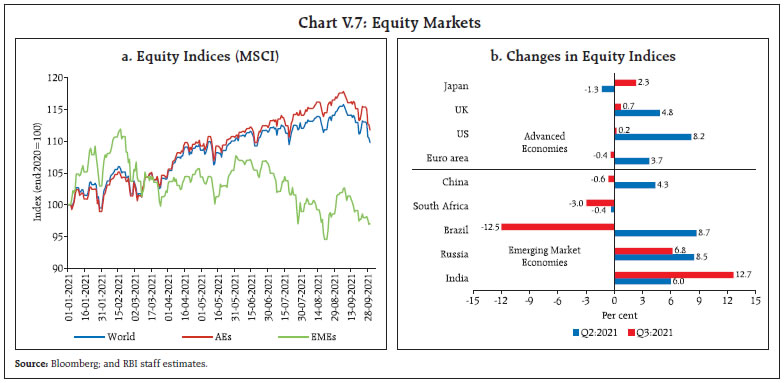 Bond yields in major AEs trended down in Q2:2021 and remained range-bound in Q3 up to August, reflecting the accommodative monetary policy stance maintained by the Fed, the ECB and the BoJ. Also, due to the persistent threat to recovery with rapid spread of the delta variant, the safe haven demand for government bonds continued. Since the September monetary policy meetings of the Fed and BoE, bond yields shot up sharply in most AEs led by large sell-offs. In the US, long-term treasury yields, which had risen at a rapid clip in Q1:2021 in line with rise in inflation expectations, treaded down in April-July even as inflation and inflation expectations remained high (Chart V.8a). In August, however, movements in long-term yields were more range-bound. Despite the significant rise in September, the 10-year yield at end-September was 25 bps lower than that prevailing at end-March 2021. 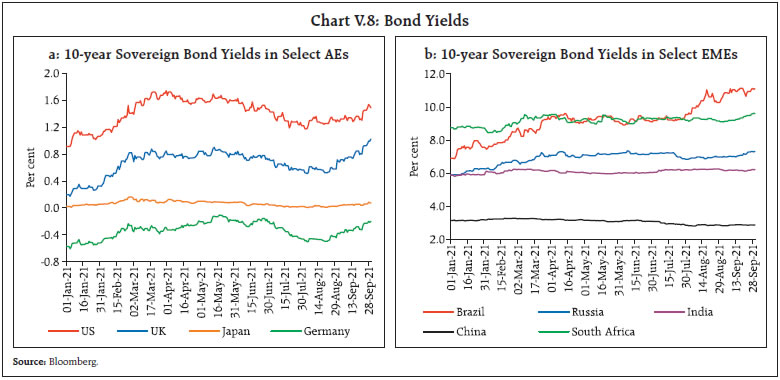 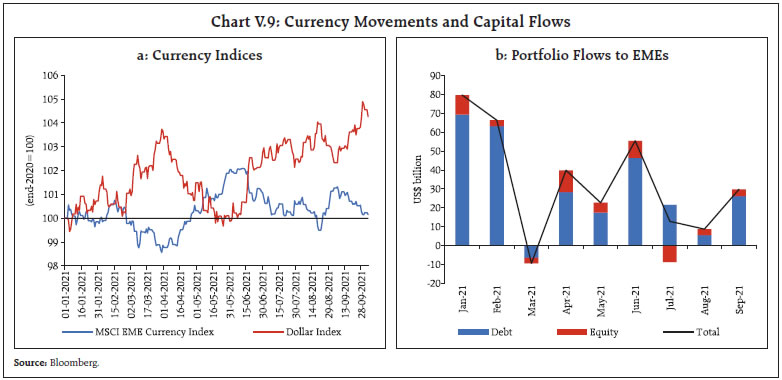 Yields in the EMEs moved bi-directionally till August – rising in those countries that began normalising monetary policy, while remaining soft in those with continued central bank support. EME bond yields rose in September, in line with the global trend (Chart V.8b). In currency markets, the US dollar has been strengthening since June 2021 on better economic prospects for the US as also higher inflation outcomes. The dollar rally strengthened in September in expectation of commencement of US taper later in 2021. In contrast, the emerging market currencies have depreciated after peaking in the second week of June (Chart V.9a). This was mainly triggered by retrenchment of capital flows following the release of the FOMC statement where dot plots suggested two likely rate rises in 2023 as against no rate hike forecast in March. Nevertheless, overall capital flows in September were higher than in August due to large sovereign bond issuances by EMEs (Chart V.9b). The MSCI Emerging Market Currency Index increased by 2.2 per cent in Q2:2021 but declined by 0.9 per cent in Q3:2021. The multi-speed economic recovery across countries is becoming increasingly susceptible to renewed bouts of rapid spread of infections. There has been a perceptible slowdown of economic activity across the globe in recent months, particularly in Asia. Inflation remains high across the world, with supply disruptions becoming more widespread. There is a risk that above target inflation may persist longer than anticipated in several economies. The pervading threat of the delta variant has led monetary authorities – that had earlier signalled unwinding – to be on hold, while incremental inflationary pressures have made others signal a sooner unwinding. __________________________________________________________________________________ 1 Artificial intelligence, internet of things, big data, blockchain, 5G, 3D printing, robotics, drone, gene editing, nanotechnology and solar photovoltaic. 2 The ACF BP filter has been applied to the natural logarithm of annual real metal prices of six non-ferrous metals, viz. copper, aluminium, lead, zinc, nickel and tin for the period 1900 to 2021. The annual prices from 1960 onwards are sourced from the World Bank. For prior period, back-casting is done by using the US Geological Survey (USGS) data. For 2021, the average of the monthly real prices (nominal prices deflated by the US CPI) from January to July is considered. 3 Long term trend can also be defined as the actual series minus all the cyclical components with periods between 2 and 70 years (i.e., both super-cycle and other shorter cyclical components) and thus BP (2,70) and BP (70, ∞) can be treated as complements. 4 These are RBI staff estimates, based on BIS database available on https://www.bis.org/publ/work934.htm. This database is for 39 major economies – 11 AEs and 28 EMEs and numerical estimates for several measures listed are not available. As such the estimate might not fully reflect the policies taken by these central banks in response to COVID-19. 5 As a multi-year project, the EU's statistical agency – Eurostat – will lead a project to include costs related to owner-occupied housing in the HICP to better measure the inflation relevant for households. In the interim, the ECB will also consider initial estimates of the cost of owner-occupied housing in conjunction with the other broader inflation measures for monetary policy assessment. 6 The previous guidance of June 2018 had set a higher threshold of 1.5 per cent. 7 Green loans/bonds, sustainability-linked loans/bonds with performance targets related to efforts on climate change and transition finance. 8 The US$ approximations for all amounts mentioned in another currency in this Chapter are based on the exchange rate (Bloomberg) on the date of announcement of the measure.
|
கடைசியாக புதுப்பிக்கப்பட்ட பக்கம்:






